BaudTec TW263R4 Wireless 802.11b/g ADSL2+ Router User Manual
BaudTec Corporation Wireless 802.11b/g ADSL2+ Router
BaudTec >
User manual
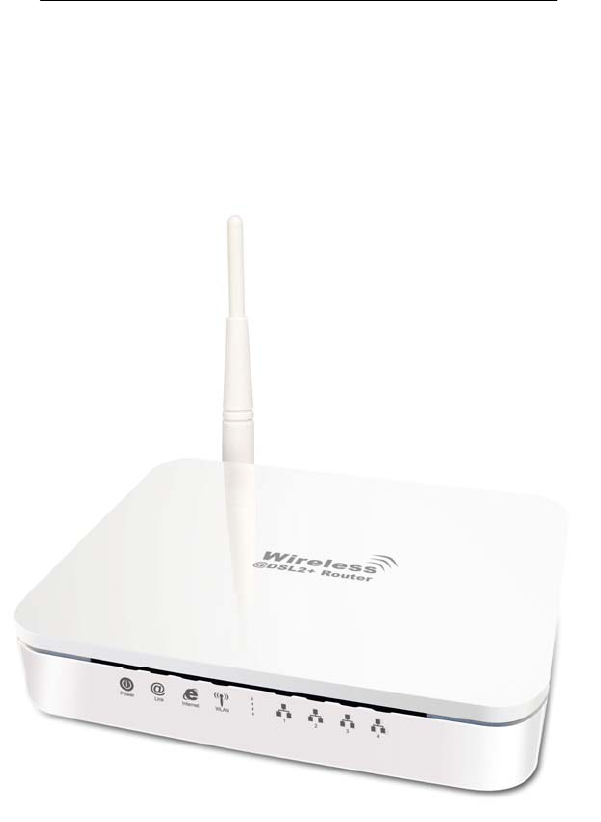
User Manual
WLAN ADSL2+ Router

INDEX
1.0 About This Manual ............................................................................................................... 1
1.1 Document Objectives .......................................................................................................... 1
1.2 Product Overview ................................................................................................................ 1
1.3 Product Description ............................................................................................................. 1
2.0 Specification......................................................................................................................... 2
2.1 LED Meaning....................................................................................................................... 3
2.2 Back Panel Connectors .......................................................................................................4
2.3 Factory Default Settings ...................................................................................................... 5
3.0 Hardware Requirements...................................................................................................... 5
3.1 Setting up the Hardware Environment ................................................................................ 5
3.2 Powering on WLAN ADSL2+ Router ................................................................................... 6
4.0 Installation & Setup.............................................................................................................. 7
5.0 Configuration Procedures....................................................................................................9
6.0 WLAN ADSL2+ Router Configuration................................................................................ 13
7.0 Technology Glossary .........................................................................................................19
8.0 Introduction of the Web Configuration............................................................................... 23
8.1 Web Configuration Overview............................................................................................. 23
8.2 Accessing WLAN ADSL2+ Router Web Configuration...................................................... 23
9.0 Universal Plug-and-Play (UPnP) ....................................................................................... 50
9.1 Universal Plug and Play Overview .................................................................................... 50
9.2 How do I know if I'm using UPnP? .................................................................................... 50
9.3 NAT Traversal .................................................................................................................... 50
9.4 Cautions with UPnP........................................................................................................... 50
9.5 Configuring UPnP.............................................................................................................. 51
9.6 Installing UPnP in Windows Example................................................................................ 52
9.7 Installing UPnP in Windows Me......................................................................................... 52
9.8 Installing UPnP in Windows XP......................................................................................... 53
9.9 Using UPnP in Windows XP Example............................................................................... 54
9.10 Auto-discover Your UPnP-enabled Network Device........................................................ 54
10.0 Web Configuration Easy Access ..................................................................................... 56
11.0 Troubleshooting ............................................................................................................... 58
A.1 Using LEDs to Diagnose Problems................................................................................... 58
A.1.1 Power LED ..................................................................................................................... 58
A.1.2 LAN LED ........................................................................................................................ 58
A.1.3 DSL LED ( ACT & LINK)................................................................................................. 58
A.2 Telnet................................................................................................................................. 58
A.3 Web Configuration............................................................................................................. 59
A.4 Login Username and Password........................................................................................ 59
A.5 LAN Interface .................................................................................................................... 59
A.6 WAN Interface ................................................................................................................... 60
A.7 Internet Access.................................................................................................................. 60
A.8 Remote Node Connection................................................................................................. 60

1
WLAN ADSL2+ Route
r
1.0 About This Manual
This manual is developed for users, system managers, network managers, and
contains installation, configuration, and operation of the WLAN ADSL2+ Router.
1.1 Document Objectives
The objectives of this manual are to describe all the initial hardware installation and
basic configuration procedure for the WLAN ADSL2+ Router. After completing the
installation and basic configuration procedures, you can then use the appropriate
contents to more completely configure your system.
1.2 Product Overview
This section provides an overview of the WLAN ADSL2+ Router. It also describes the
general applications available with the WLAN ADSL2+ Router.
1.3 Product Description
WLAN ADSL2+ Router is a low cost, high performance and high-speed device that
provides a full rate ADSL2+ Router with the superb reliability and a complete solution
for home and office router. WLAN ADSL2+ Router can have a maximum downstream
data rate of up to 24Mbps and an upstream of up to 1Mbps. When configured as a
DHCP server, it will assign IP address to every connected PC and acts as the only
externally recognized Internet device on your local area network. With build-in NAT,
WLAN ADSL2+ Router serves as an Internet firewall, protecting your network from
being accessed by outside users. You can safely enjoy the new generation broadband
Internet with WLAN ADSL2+ Router.
FCC Notice
This equipment has been tested and found to comply with the limits for a Class B digital device, pursuant to
part 15 of the FCC rules. These limits are designed to provide reasonable protection against harmful
interference in a residential installation. This equipment generates uses and can radiate radio frequency
energy and, if not installed and used in accordance with the instructions, may cause harmful interference to
radio communications. However, there is no guarantee that interference will not occur in a particular
installation. If this equipment does cause harmful interference to radio or television reception, which can be
determined by turning the equipment off and on, the user is encouraged to try to correct the interference by
one or more of the following measures:
-Reorient or relocate the receiving antenna. -Increase the separation between the equipment and receiver.
-Connect the equipment into an outlet on a circuit different from that to which the receiver is connected.
-Consult the dealer or an experienced radio/TV technician for help.
FCC RF Radiation Exposure Statement:
1. This Transmitter must not be co-located or operating in conjunction with any other antenna or
transmitter.
2. This equipment complies with FCC RF radiation exposure limits set forth for an uncontrolled environment.
This equipment should be installed and operated with a minimum distance of 20 centimeters between the
radiator and your body.
You are cautioned that changes or modifications not expressly approved by the party responsible for
compliance could void your authority to operate the equipment.
Note! This section documents general product features
available in the WLAN ADSL2+ Router product series. Please
refer to the release notes for a current list of upgraded
hardware and software s
p
ecifications.

2
WLAN ADSL2+ Route
r
2.0 Specification
ADSL Standards supported
●Compliant to ITU-T G.992.1 (G.dmt), G.992.2 (G.lite),
G.992.3 (ADSL2), G.992.4 (splitterless ADSL2), G.992.5 (ADSL2+) for Annex A, B
●G.lite (G.992.2) with line rate support of up to 1.5Mbps downstream and 512Kbps upstream.
●Supports Multi-Mode standard (ANSI T1.413, Issue 2; G.dmt (G.992.1); G.994.1 and
G.996.1(for ISDN only); G.991.1;G.lite (G992.2)).
●Supports OAM F4/F5 loop-back, AIS and RDI OAM cells.
●ATM Forum UNI 3.1/4.0 PVC.
●Supports up to 8 PVCs (UBR, CBR, VBR).
●Multiple Protocols over AAL5 (RFC 1483).
●PPP over AAL5 (RFC 2364).
●PPP over Ethernet (RFC 2516).
Wireless Ethernet 802.11g
With built-in 802.11g access point for extending the communication media to WLAN
while providing the WEP and WPA for securing your wireless networks.
Network Address Translation (NAT)
Network Address Translation (NAT) allows the translation of an Internet protocol address used
within one network (for example a private IP address used in a local network) to a different IP
address known within another network (for example a public IP address used on the Internet).
Universal Plug and Play (UPnP)
Using the standard TCP/IP protocol, the WLAN ADSL2+ Router and other UPnP enabled
devices can dynamically join a network, obtain an IP address and convey its capabilities to
other devices on the network.
10/100M Auto-negotiation Ethernet / Fast Ethernet Interface
This auto-negotiation feature allows the WLAN ADSL2+ Router to detect the speed of
incoming transmissions and adjust appropriately without manual intervention. It allows data
transfer of either 10 Mbps or 100 Mbps in either half-duplex or full-duplex mode depending on
your Ethernet network.
Dynamic DNS Support
With Dynamic DNS support, you can have a static hostname alias for a dynamic IP address,
Multiple PVC (Permanent Virtual Circuits) Support
Your WLAN ADSL2+ Router supports up to 8 PVC’s.
DHCP Support
DHCP (Dynamic Host Configuration Protocol) allows individual clients (computers) to obtain
TCP/IP configuration at start-up from a centralized DHCP server. The WLAN ADSL2+ Router
has built-in DHCP server capability enabled by default. It can assign IP addresses, an IP
default gateway and DNS servers to DHCP clients. The WLAN ADSL2+ Router can now also
act as a surrogate DHCP server (DHCP Relay) where it relays IP address assignment from the
actual real DHCP server to the clients.
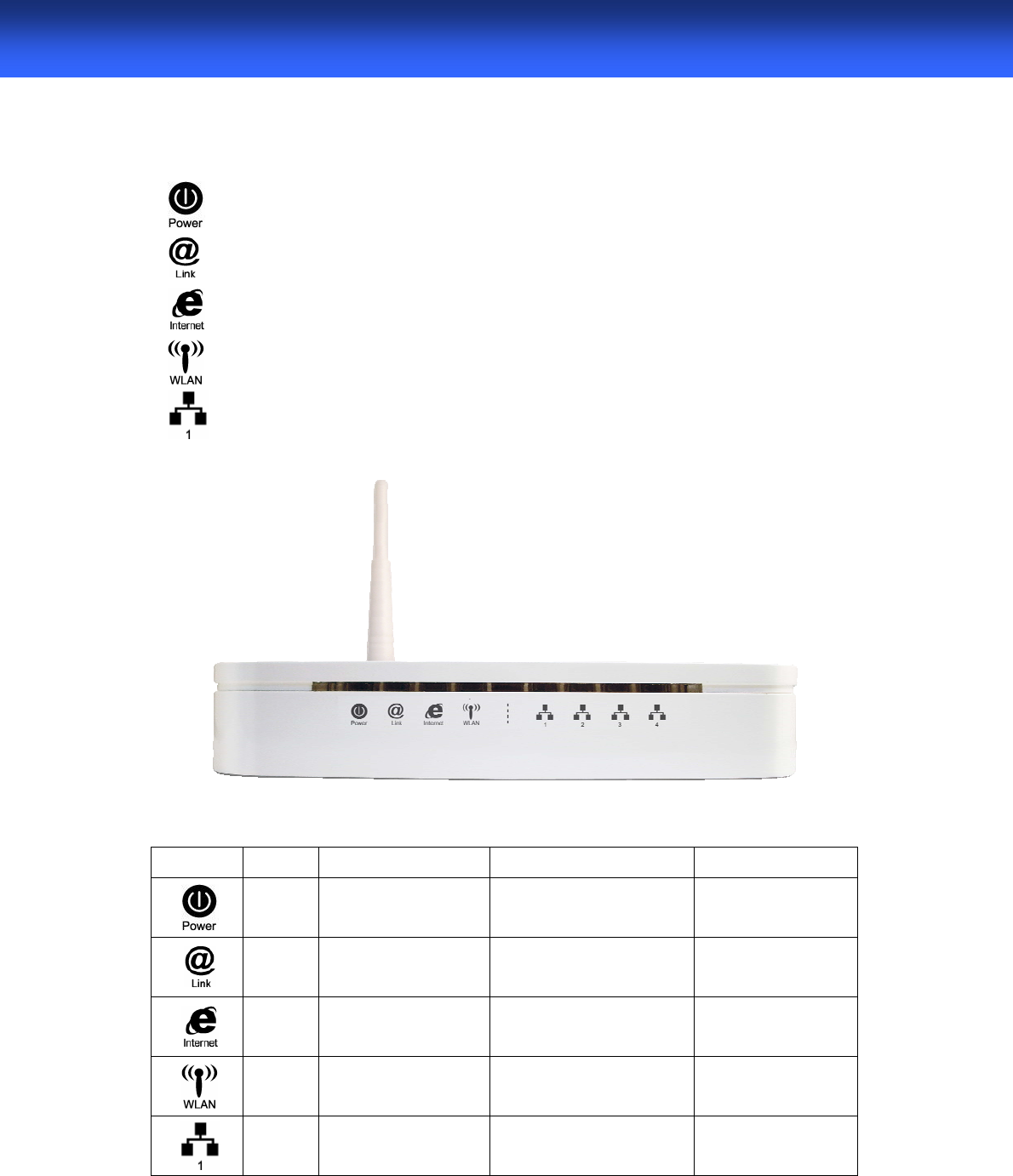
3
WLAN ADSL2+ Route
r
2.1 LED Meaning
Your WLAN ADSL2+ Router has indicator lights on the front side. Please see below for an
explanation of the function of each indicator light.
Power indicator
ADSL Link indicator
Internet Active indicator
Wireless Active indicator
Ethernet Active indicator
Table 1. LED function
Label Color On Flash Off
Green Ready Not Ready Power Off
Green Connect to DSLAM Disconnect to DSLAM N/A
Green Connect to Internet
/IDLE Transmit / Receive Data Disconnect to
Internet
Green N/A Wireless Activated Deactivated
Green Ethernet Connected Transmit / Receive Data Ethernet
Disconnected
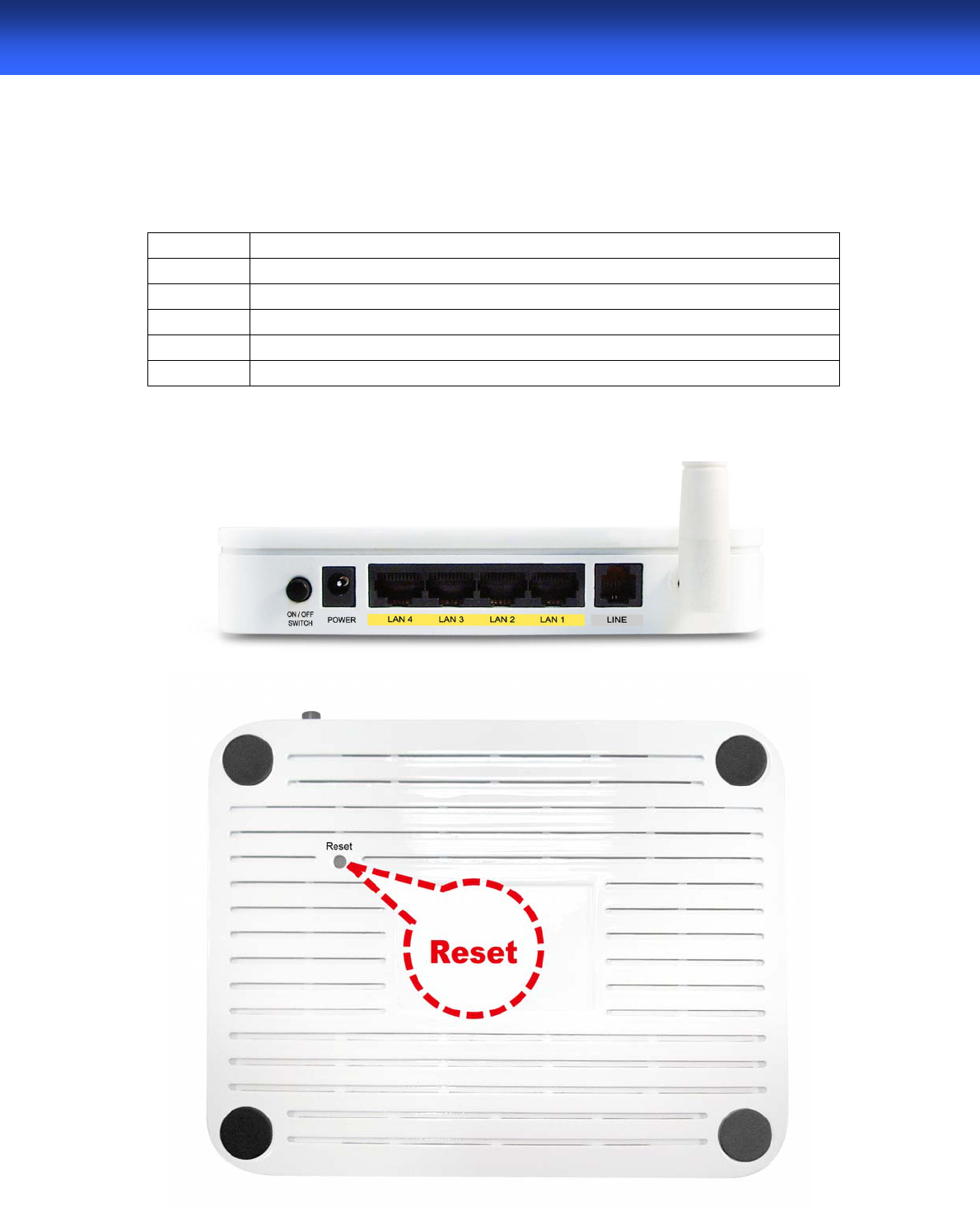
4
WLAN ADSL2+ Route
r
2.2 Back Panel Connectors
Table 2 shows the function of each connector and switch of the WLAN ADSL2+
Router’s back panel. Figure 1 illustrated the connectors.
Table 2. Function / Description of Connectors
Connector Description
RESET Reset bottom, RESET the WLAN ADSL2+ router to its default settings
SWITCH Power Switch
POWER Connects to your WLAN ADSL2+ router 12Vac power adaptor
LAN1~4 RJ-45 Jack (Ethernet Cable) connection to your PC, or HUB
LINE Connects to your ADSL2+ line – for ADSL2+ Line input
Figure1. Rear View of the WLAN ADSL2+ Router

5
WLAN ADSL2+ Route
r
2.3 Factory Default Settings
Before configuration, please refer to following default settings,
Web interface:
Username: admin
Password: 1234
LAN IP Settings:
IP Address: 192.168.1.1
Subnet Mask: 255.255.255.0
DHCP:
DHCP Server: Enable
3.0 Hardware Requirements
To use WLAN ADSL2+ Router, please have following hardware / accessories ready.
A PC with Pre-installed Ethernet Adapter (Required)
12Vac power adaptor (Included in the package)
RJ-45 Ethernet cable (Included in the package)
RJ-11cable (Included in the package)
3.1 Setting up the Hardware Environment
Please kindly refer to chapter 4.0 “Installation & Setup”
Note! Be sure that you are well insulated from any power
source to avoid electricity shock.

6
WLAN ADSL2+ Route
r
3.2 Powering on WLAN ADSL2+ Router
1. Connect the power to the WLAN ADSL2+ Router by plugging the power
supply into an appropriate electrical outlet.
2. If the Power LED is off, refer to “Troubleshooting” for information.
Please kindly refer to chapter 4.0 “Installation & Setup”
Note! Use only the manufacturer-approved power supply that
shipped with the WLAN ADSL2+ Router.
Important Notice!
For software installation, please refer to the file inside your CD.
CD ROM :\MANUAL\Manual.pdf.
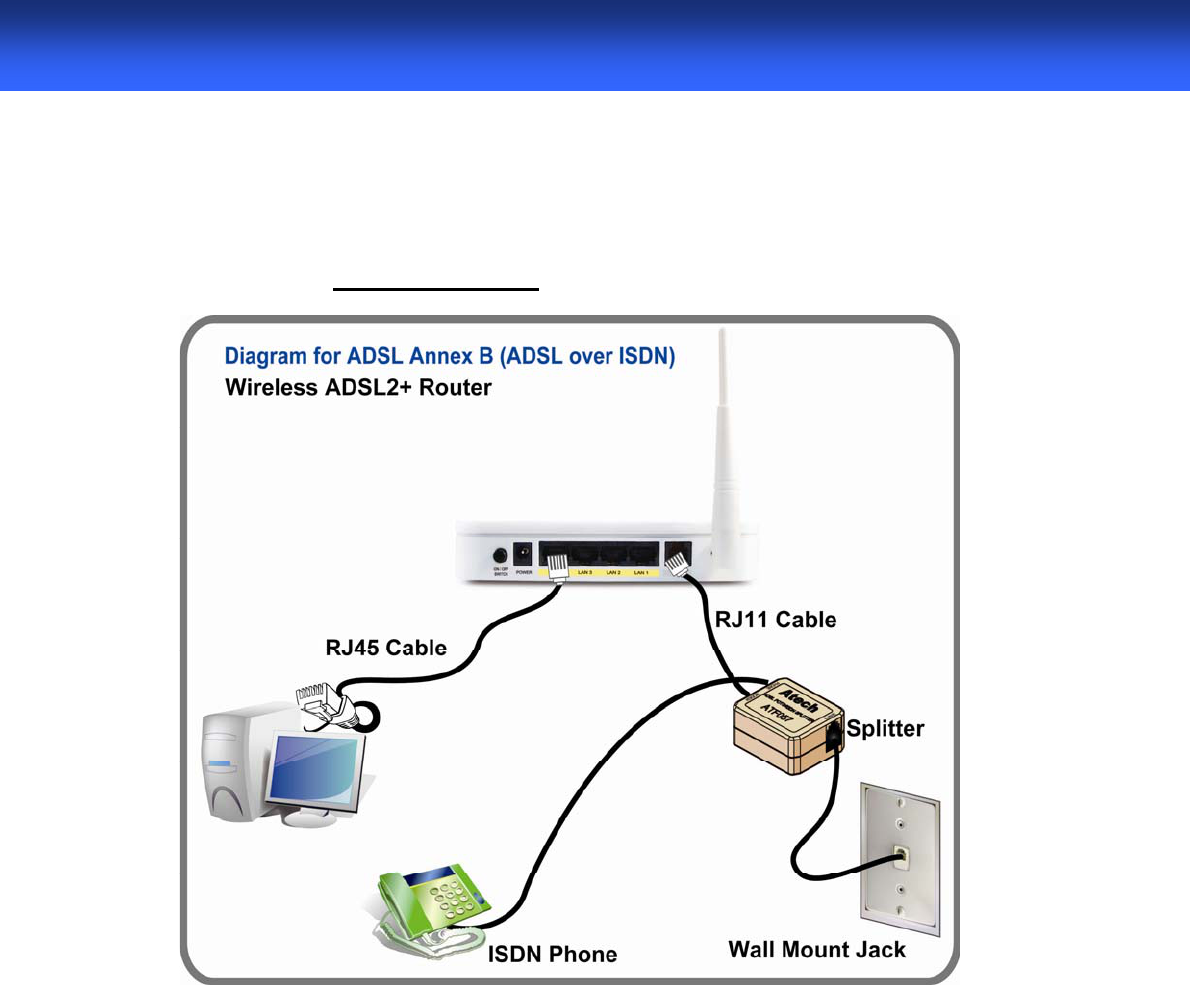
7
WLAN ADSL2+ Route
r
4.0 Installation & Setup
Follow each STEP carefully and only go to the next step once you have complete the
previous STEP.
Connection of WLAN ADSL2+ Router
If you have an ISDN telephone line connect the modem router as shown below:
1. Connect the supplied RJ45 Ethernet cable from your PC's Ethernet port to any of
the 4 WLAN ADSL2+ Router's LAN Ports.
2. Connect the supplied RJ11 telephone cable from your home's telephone jack to
the “LINE” port of the supplied splitter. Connect another RJ11 telephone cable to
the “MODEM” port of the splitter and connect the other end of this cable to the
LINE port of your WLAN ADSL2+ Router.
3. Connect a RJ11 telephone cable to the “PHONE” port of the splitter and connect
the other end to your telephone.
4. Connect the power adapter to the power inlet “POWER” of the WLAN ADSL2+
Router and turn the “ON/OFF SWITCH” switch of your WLAN ADSL2+ Router on.
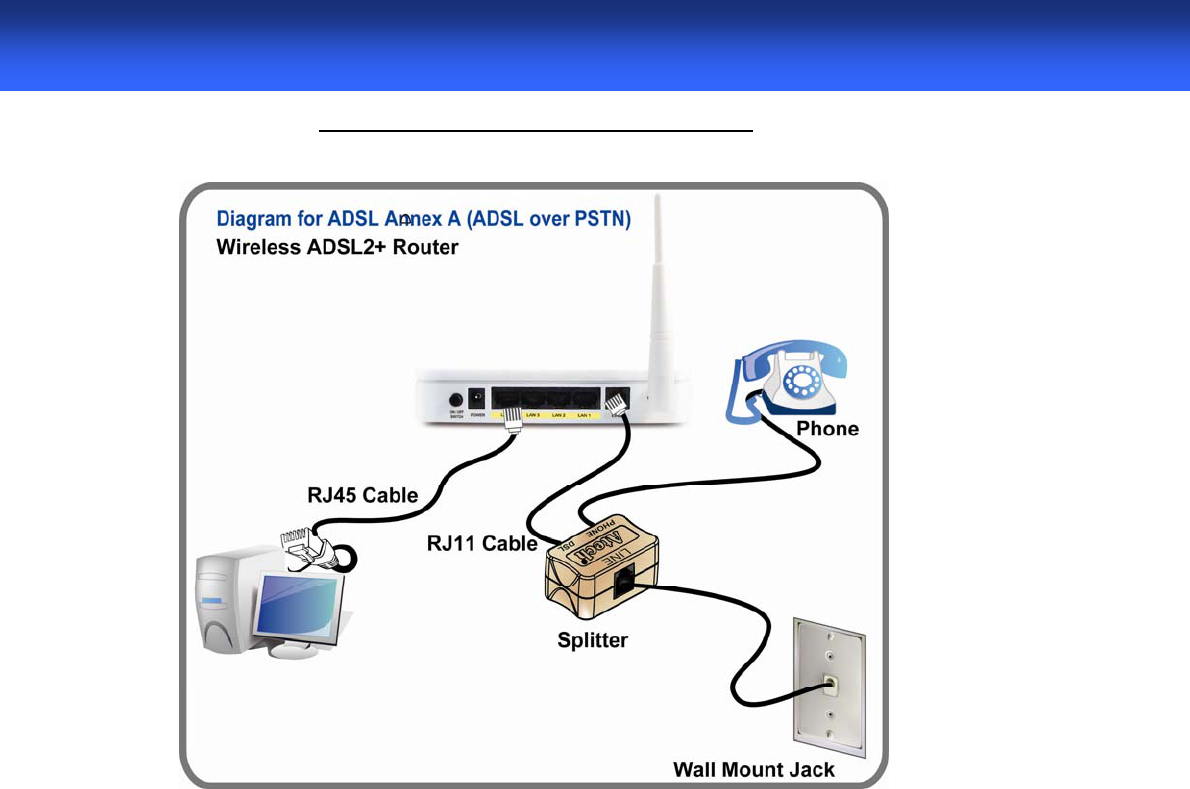
8
WLAN ADSL2+ Route
r
If you have a PSTN telephone line (normal analog line) connect the router as
shown below:
1. Connect the supplied RJ45 Ethernet cable from your PC's Ethernet port to any of
the 4 WLAN ADSL2+ Router's LAN Ports.
2. Connect the supplied RJ11 telephone cable from your home's telephone jack to
the “LINE” port of the supplied splitter. Connect the other supplied RJ11 telephone
cable to the “DSL” port of the splitter and connect the other end of this cable to the
“LINE” port of your WLAN ADSL2+ Router.
3. Connect a RJ11 telephone cable to the “PHONE” port of the splitter and connect
the other end to your telephone.
4. Connect the power adapter to the power inlet “POWER” of the WLAN ADSL2+
Router and turn the “ON/OFF SWITCH” switch of your WLAN ADSL2+ Router on.
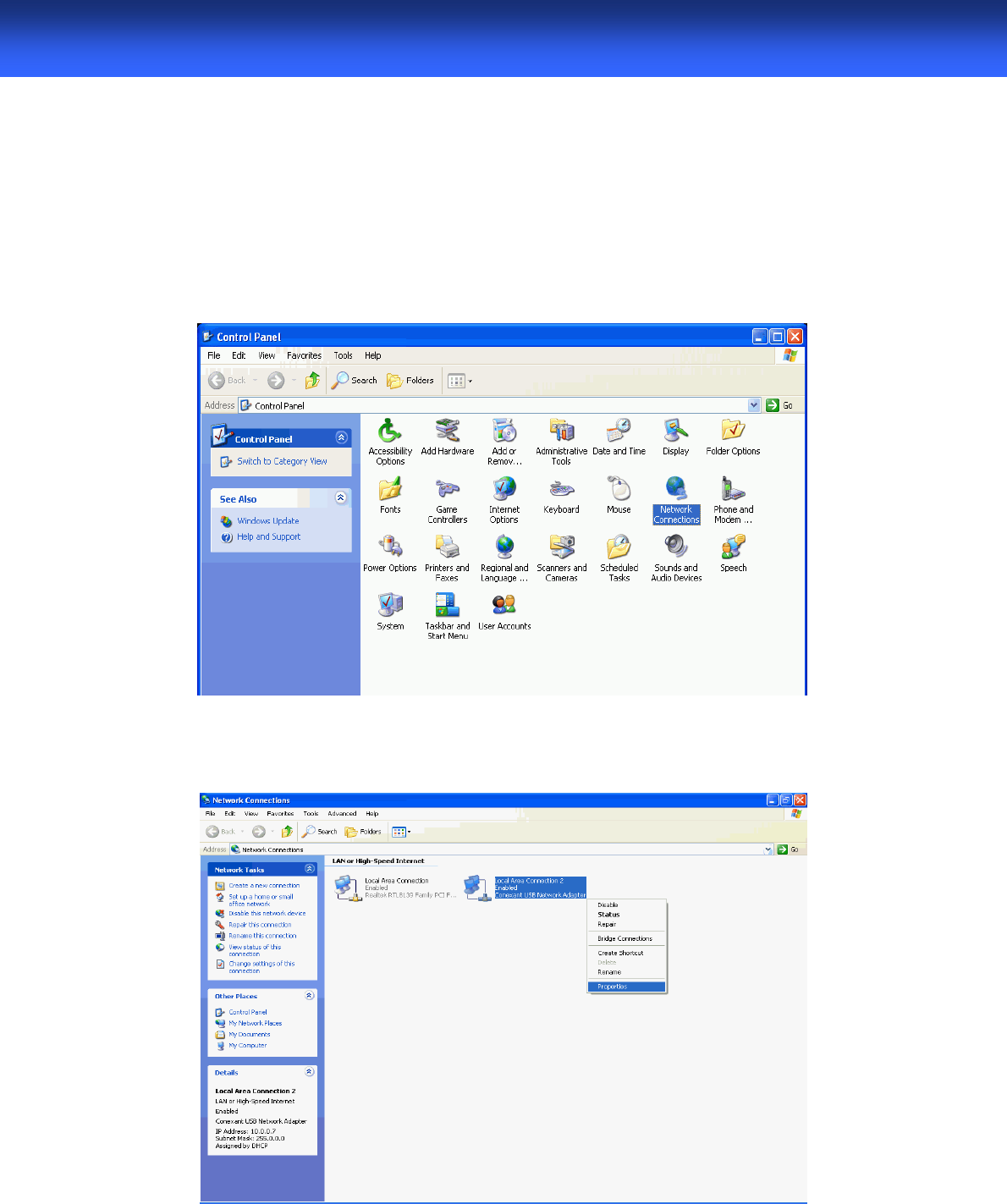
9
WLAN ADSL2+ Route
r
5.0 Configuration Procedures
Before starting the WLAN ADSL2+ Router configuration, please kindly
configure the PC computer as below, to have automatic IP address / DNS
Server.
For Windows 98SE/ME/2000/XP
1. Click on "Start” -> “Control Panel” (in Classic View). In the Control
Panel; double click on "Network Connections" to continue.
2. Single RIGHT click on “Local Area connection", then click
"Properties".
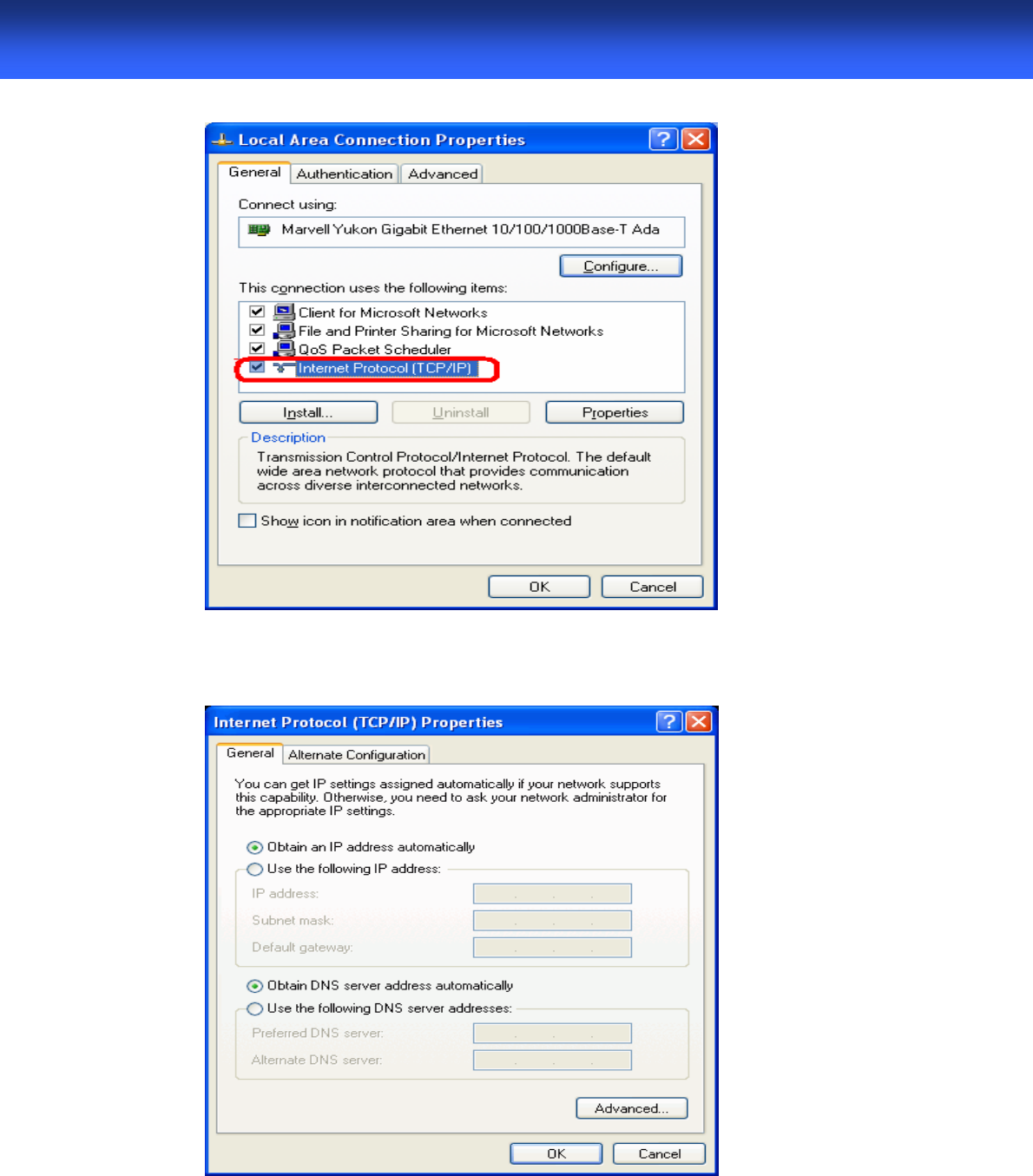
10
WLAN ADSL2+ Route
r
3. Double click on "Internet Protocol (TCP/IP)".
4. Check "Obtain an IP address automatically" and “Obtain DNS
server address automatically” then click on "OK" to continue.
5. Click "Show icon in notification area when connected" (see screen
image in 3. above) then Click on "OK" to complete the setup procedures.
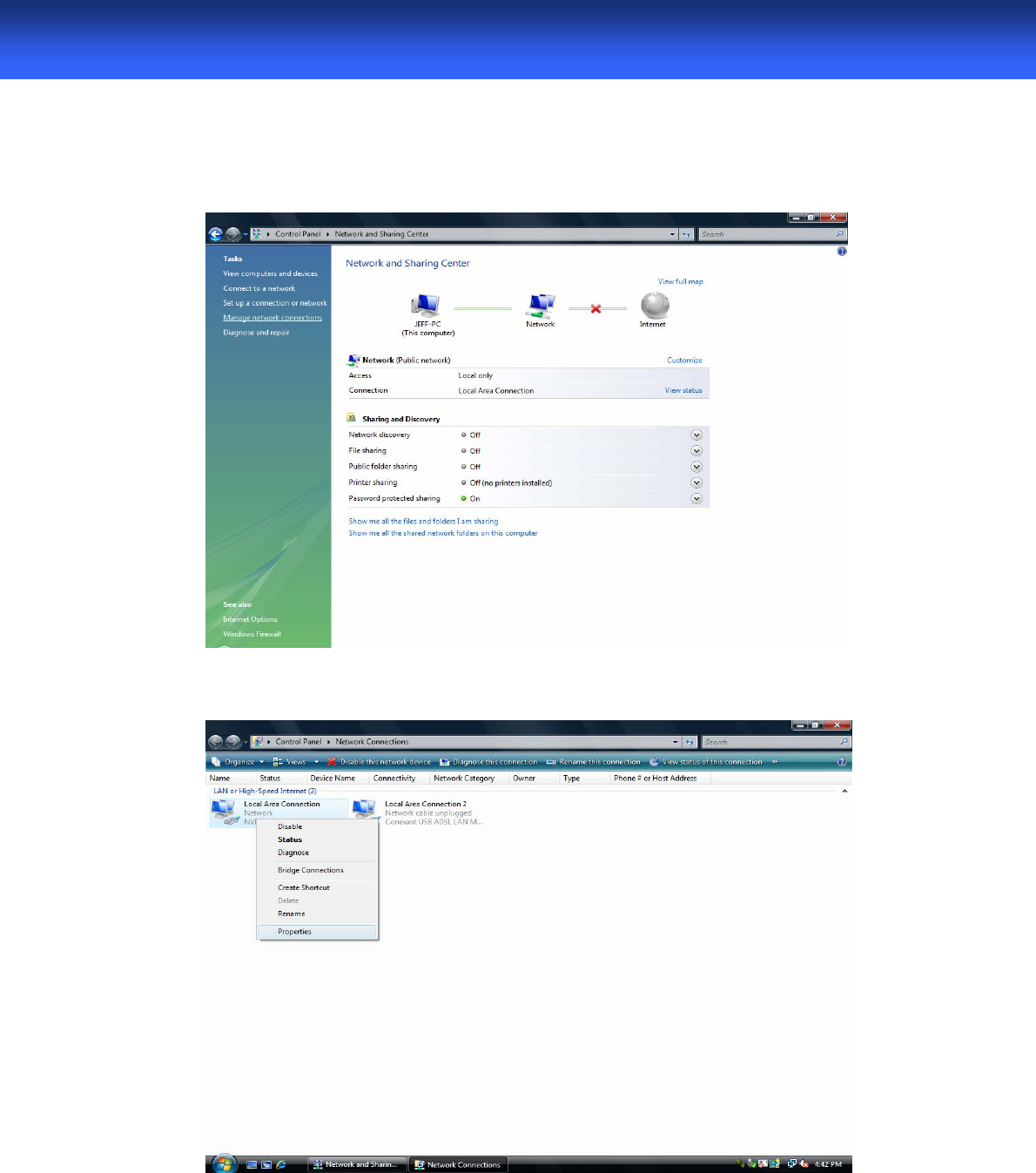
11
WLAN ADSL2+ Route
r
For Windows Vista-32/64
1. Click on "Start” -> “Control Panel” (in Classic View) -> “Network and
Sharing Center”. In the Manage network connections, double click on
"Manage network connections" to continue.
2. Single RIGHT click on “Local Area connection", then click "Properties".
3. The screen will display the information “User Account Control” and click
“Continue” to continue.
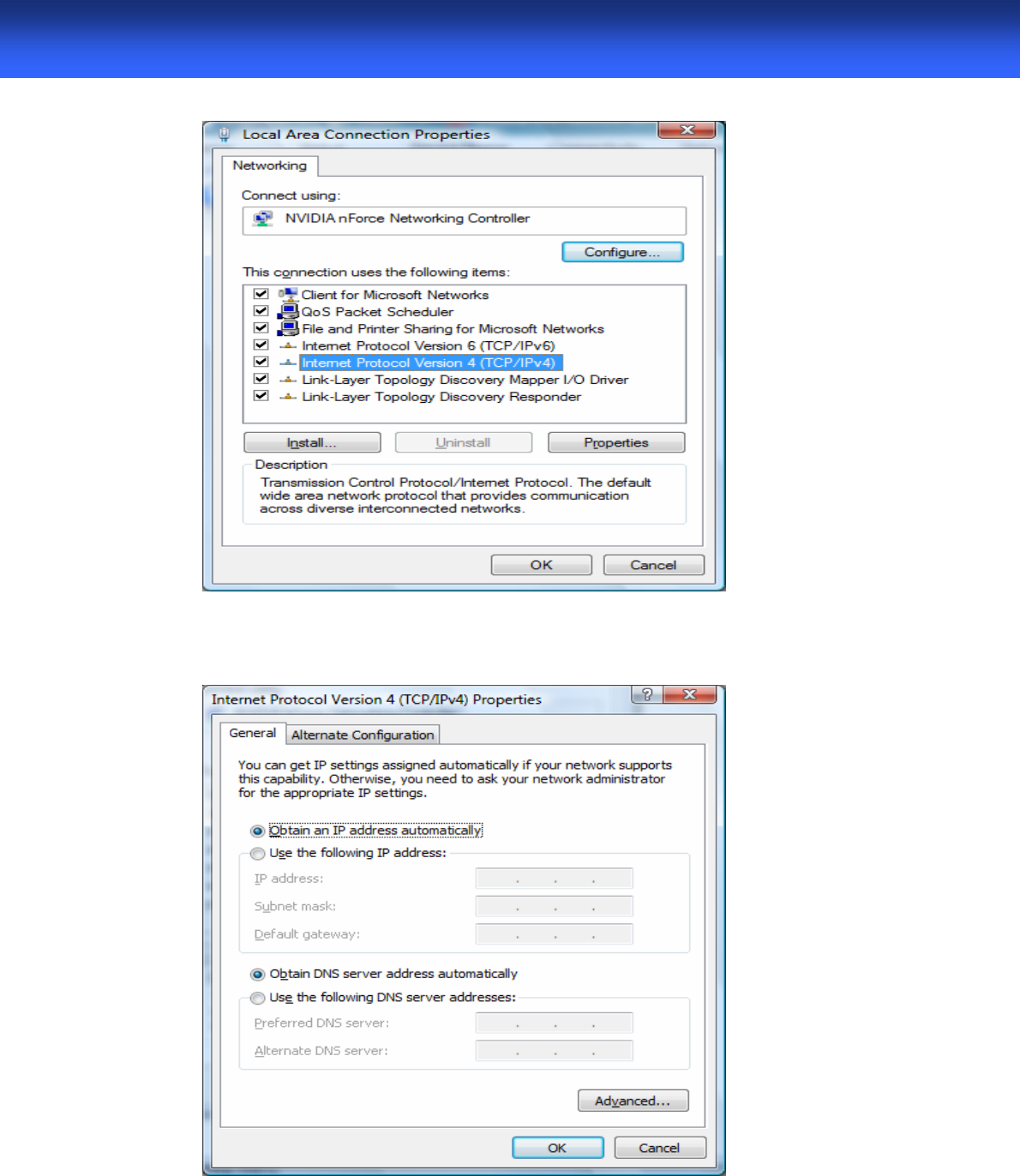
12
WLAN ADSL2+ Route
r
4. Double click on "Internet Protocol Version 4 (TCP/IPv4)"
5. Check "Obtain an IP address automatically" and “Obtain DNS server
address automatically” then click on "OK" to continue.
6. You can see the screen will appear as shown in Step 4. above, then click “OK”
to complete the setup procedures.
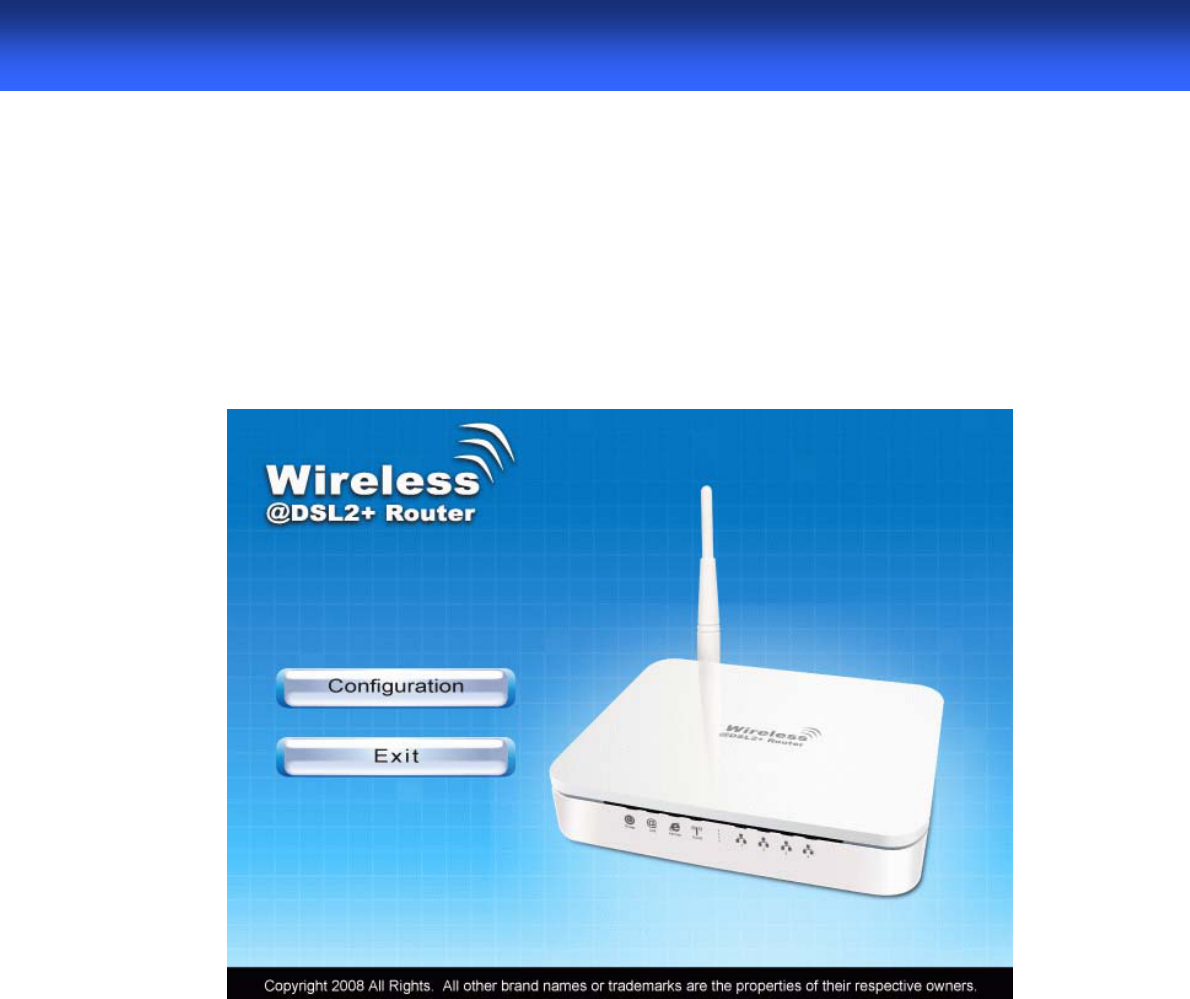
13
WLAN ADSL2+ Route
r
6.0 WLAN ADSL2+ Router Configuration
1. Please insert the supplied CD into your CD-ROM drive.
2. The CD should auto-start, displaying the window shown in 3. below. If
your CD does not start automatically, go to Windows Explorer, Select
your CD drive and double click “setup.exe”.
3. To configure the device, please click “Configuration”.
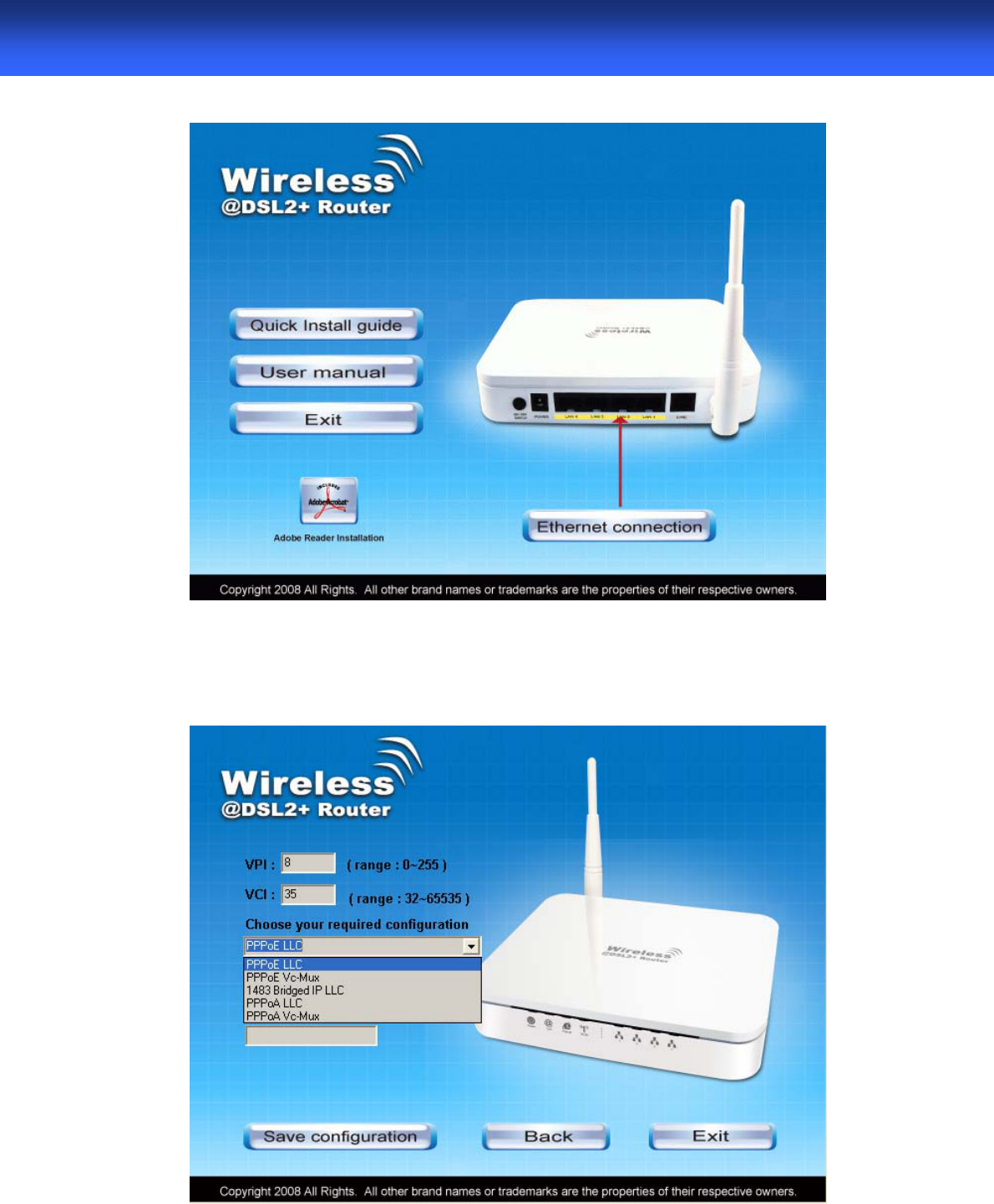
14
WLAN ADSL2+ Route
r
4. Please click “Ethernet connection” button to continue.
5. Enter the VPI, VCI, Username and Password your ISP (Internet
Services Provider) provided, and choose your required configuration.
Then press “Save Configuration”. Please wait for about 30 seconds.
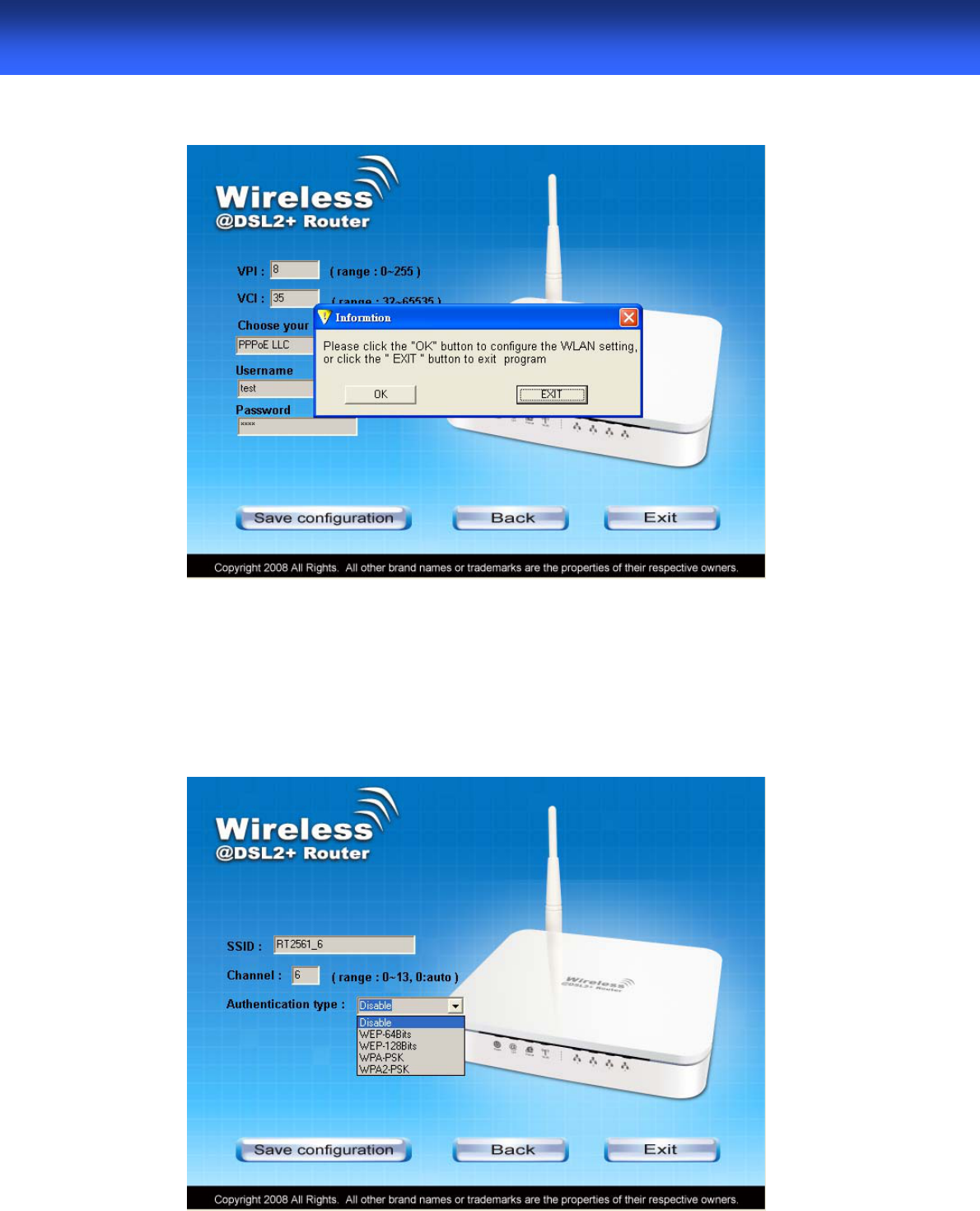
15
WLAN ADSL2+ Route
r
6. When the “information” screen pop-up, please click “OK” button to
configure the WLAN setting, or click “EXIT” button to exit program.
7. Please enter the SSID and wireless channel if you want to change
(the default setting SSID=RT2561_6, Channel=6). Choose the
Authentication type if necessary, as Disable / WEP-64bits /
WEP-128bits / WPA-PSK and WPA2-PSK. For example, you choose
the WEP 64bits type and save the authentication keys in key 1,
displaying the screen shown in 8. below.
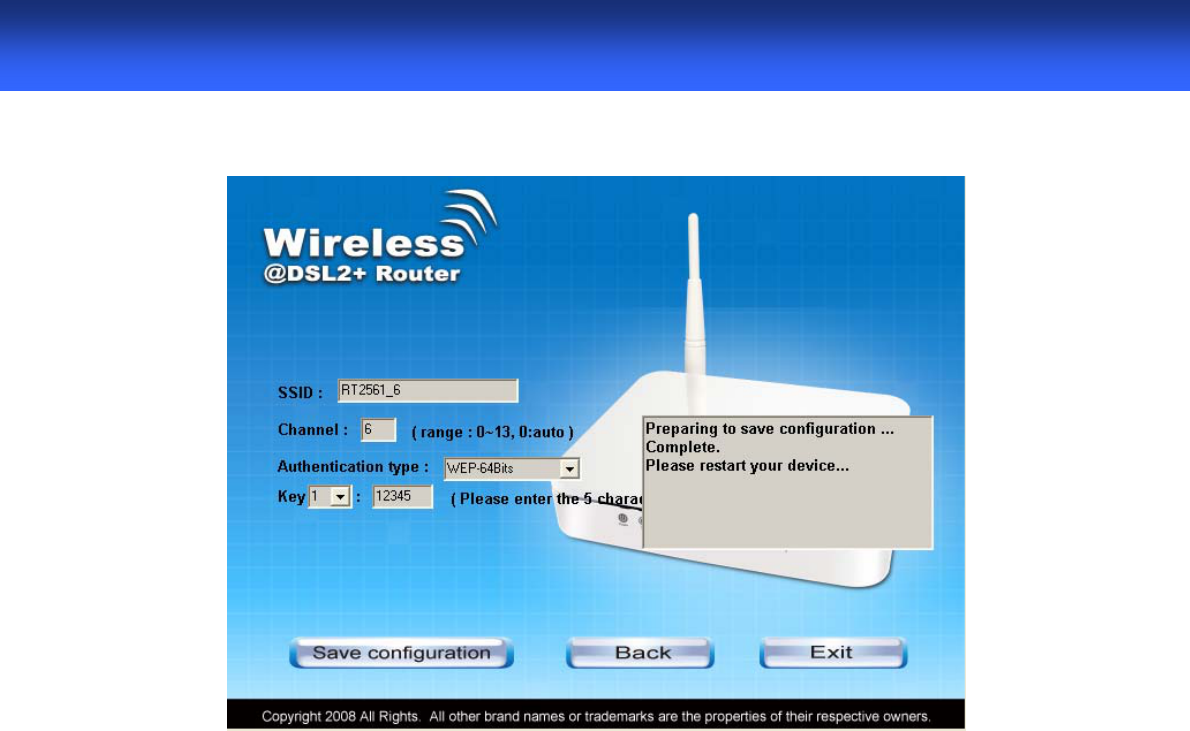
16
WLAN ADSL2+ Route
r
8. Please click on “Save configuration” button. When the procedure is
completed, the program will exit.
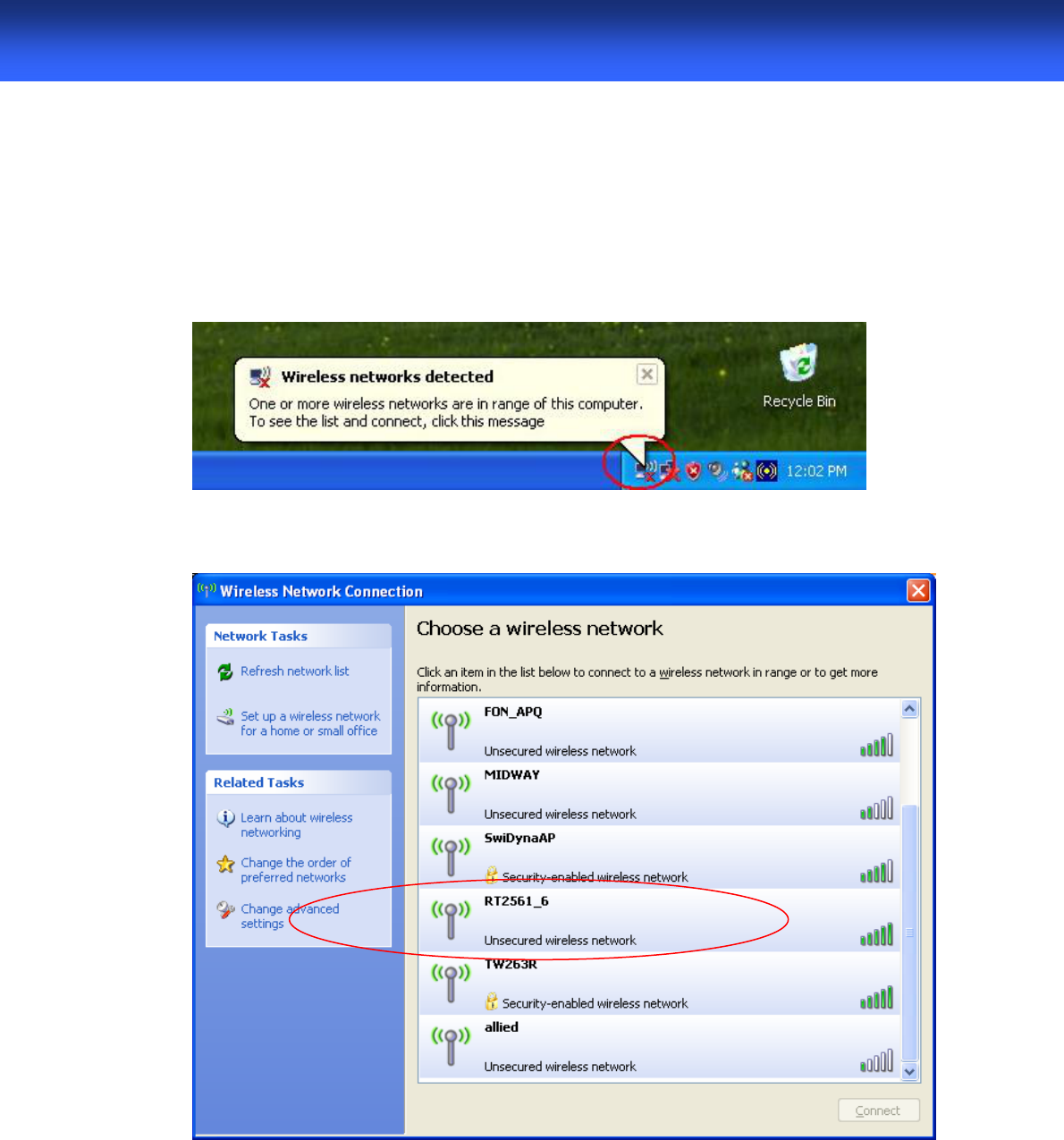
17
WLAN ADSL2+ Route
r
6.1 Connect Wirelessly
For easy installation it is saved to keep the settings. You can later change
the wireless settings via the wireless configuration menu. (see user manual
on the CD – Chapter 8 and other)
1. Double click on the wireless icon on your computer and search for the
wireless network that you enter SSID name.
2. Click on the wireless network that you enter SSID name to connect
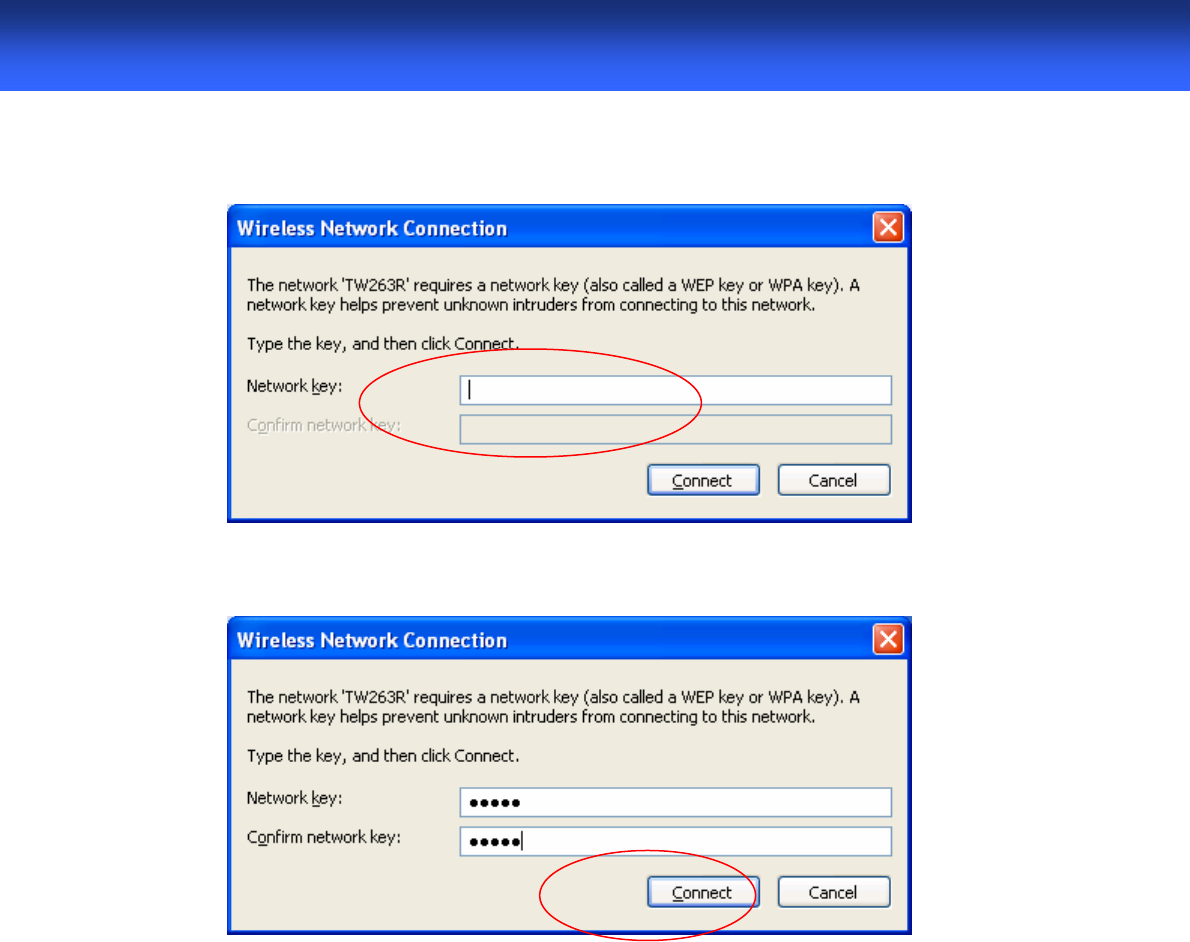
18
WLAN ADSL2+ Route
r
4. Enter the network key that belongs to your authentication type and key.
You can later change this network key via the wireless configuration
menu. (see user manual on the CD – Chapter 8 and other)
5. Click on “Connect” or Apply
Now, the WLAN ADSL2+ Router has been configured, and able to
connect to ISP/ Website.

19
WLAN ADSL2+ Route
r
7.0 Technology Glossary
10Base-T
An adaptation of the Ethernet standard for Local Area Network (LAN).
10Base-T uses a twisted pair cable with maximum length of 100 meters.
AAL
ATM Adaptation Layer that defines the rules governing segmentation and
reassembly of data into cells. Different AAL types are suited to different traffic
classes.
Address mask
A bit mask used to select bits from an Internet address for subnet addressing.
The mask is 32 bits long and selects the network portion of the Internet
address and one or more bits of the local portion. Sometimes called subnet
mask.
ADSL
Asymmetric Digital Subscriber Line, as it’s name showing, is an asymmetrical
data transmission technology with high traffic rate downstream and low traffic
rate upstream. ADSL technology satisfies the bandwidth requirement of
applications, which demand “asymmetric” traffic, such as web surfing, file
download and Video-on-demand (VOD).
ATM
Asynchronous Transfer Mode is a layer 2 protocol supporting high-speed
asynchronous data with advanced traffic management and quality of service
features.
bps
Bits per second. A standard measurement of digital transmission speeds.
Bridge
A device that connects two or more physical networks and forwards packets
between them. Bridges can usually be made to filter packets, that is, to forward
only certain traffic. Related devices are: repeaters which simply forward
electrical signals from one cable to the other, and full-fledged routers which
make routing decisions based on several criteria.
CPE
Customer Premises Equipment, such as ADSL router, USB modem.
DHCP
Dynamic Host Configuration Protocol. Used for assigning dynamic IP address
to devices on a network. Used by ISPs for dialup users.
DNS
Domain Name Server, translates domain names into IP addresses to help user
recognize and remember. However, the Internet actually runs on numbered IP
addresses, DNS servers needs to translate domain names back to their
respective IP addresses.

20
WLAN ADSL2+ Route
r
DSL
Digital Line Subscriber (DSL) technology provides high-speed access over
twisted copper pair for connection to the Internet, LAN interfaces, and to
broadband services such as video-on-demand, distance learning, and video
conferencing.
FTP
File Transfer Protocol. The Internet protocol (and program) used to transfer
files between hosts.
IPoA (RFC 1577)
Classical IP and ARP over ATM. Considers ATM configured as a Logic IP
Sub-network(LIS) to replace Ethernet local LAN segments.
ISP
Internet service provider. A company that allows home and corporate users to
connect to the Internet.
LAN
Local area network. A limited distance (typically under a few kilometers or a
couple of miles) high-speed network (typically 4 to 100 Mbps) that supports
many computers.
MAC
Media Access Control Layer. A sub-layer of the Data Link Layer (Layer 2) of
the ISO OSI Model responsible for media control.
MTU
Maximum Transmission Unit
NAT
Network Address Translator as defined by RFC 1631. Enables a LAN to use
one set of IP address for internal traffic. A NAT box located where the LAN
meets the Internet provides the necessary IP address translation. This helps
provide a sort of firewall and allow for a wider address range to be used
internally without danger of conflict.
PPP
Point-to-Point-Protocol. The successor to SLIP, PPP provides router-to-router
and host-to-network connections over both synchronous and asynchronous
circuits.
PPPoA (RFC 2364)
The Point-to-Point Protocol(PPP) provides a standard method for transporting
multi-protocol datagrams over point-to-point links. This document describes
the use of ATM Adaptation Layer 5 (AAL5) for framing PPP encapsulated
packets.

21
WLAN ADSL2+ Route
r
PPPoE (RFC 2516)
This document describes how to build PPP sessions and encapsulate PPP
packets over Ethernet. PPP over Ethernet (PPPoE) provides the ability to
connect a network of hosts over a simple bridging access device to a remote
Access Concentrator.
PVC
Permanent Virtual Circuit. Connection-oriented permanent leased line circuit
between end-stations on a network over a separate ATM circuit.
RFC
Request for Comments. The document series, begun in 1969, which describes
the Internet suite of protocols and related experiments. Not all RFCs describe
Internet standards, but all Internet standards are written up as RFCs
RFC 1483
Multi-protocol encapsulation over AAL-5. Two encapsulation methods for
carrying network interconnect traffic over ATM AAL-5. The first method allows
multiplexing of multiple protocols over a single ATM virtual circuit. The
protocol of a carried PDU is identified by prefixing the PDU by an IEEE 802.2
Logical Link Control (LLC) header. This method is in the following called
"LLC Encapsulation". The second method does higher-layer protocol
multiplexing implicitly by ATM Virtual Circuits (VCs). It is in the following
called "VC Based Multiplexing".
Router
A system responsible for making decisions about which of several paths
network (or Internet) traffic will follow. To do this, it uses a routing protocol to
gain information about the network and algorithms to choose the best route
based on several criteria known as "routing metrics.
Spanning Tree
Spanning-Tree Bridge Protocol (STP). Part of an IEEE standard. A mechanism
for detecting and preventing loops from occurring in a multi-bridged
environment. When bridges connect three or more LAN segments, a loop can
occur. Because a bridge forwards all packets that are not recognized as being
local, some packets can circulate for long periods of time, eventually degrading
system performance. This algorithm ensures only one path connects any pair
of stations, selecting one bridge as the 'root' bridge, with the highest priority
one as identifier, from which all paths should radiate.
TELNET
The virtual terminal protocol in the Internet suite of protocols. Allows users of
one host to log into a remote host and act as normal terminal users of that
host.
VCI
Virtual Circuit Identifier. Part of the ATM cell header, a VCI is a tag indicating
the channel over which a cell will travel. The VCI of a cell can be changed as it
moves between switches via Signaling.

22
WLAN ADSL2+ Route
r
VPI
Virtual Path Identifier. Part of the ATM cell header, a VPI is a pipe for a number
of Virtual Circuits.
WAN
Wide area network. A data communications network that spans any distance
and is usually provided by a public carrier (such as a telephone company or
service provider)
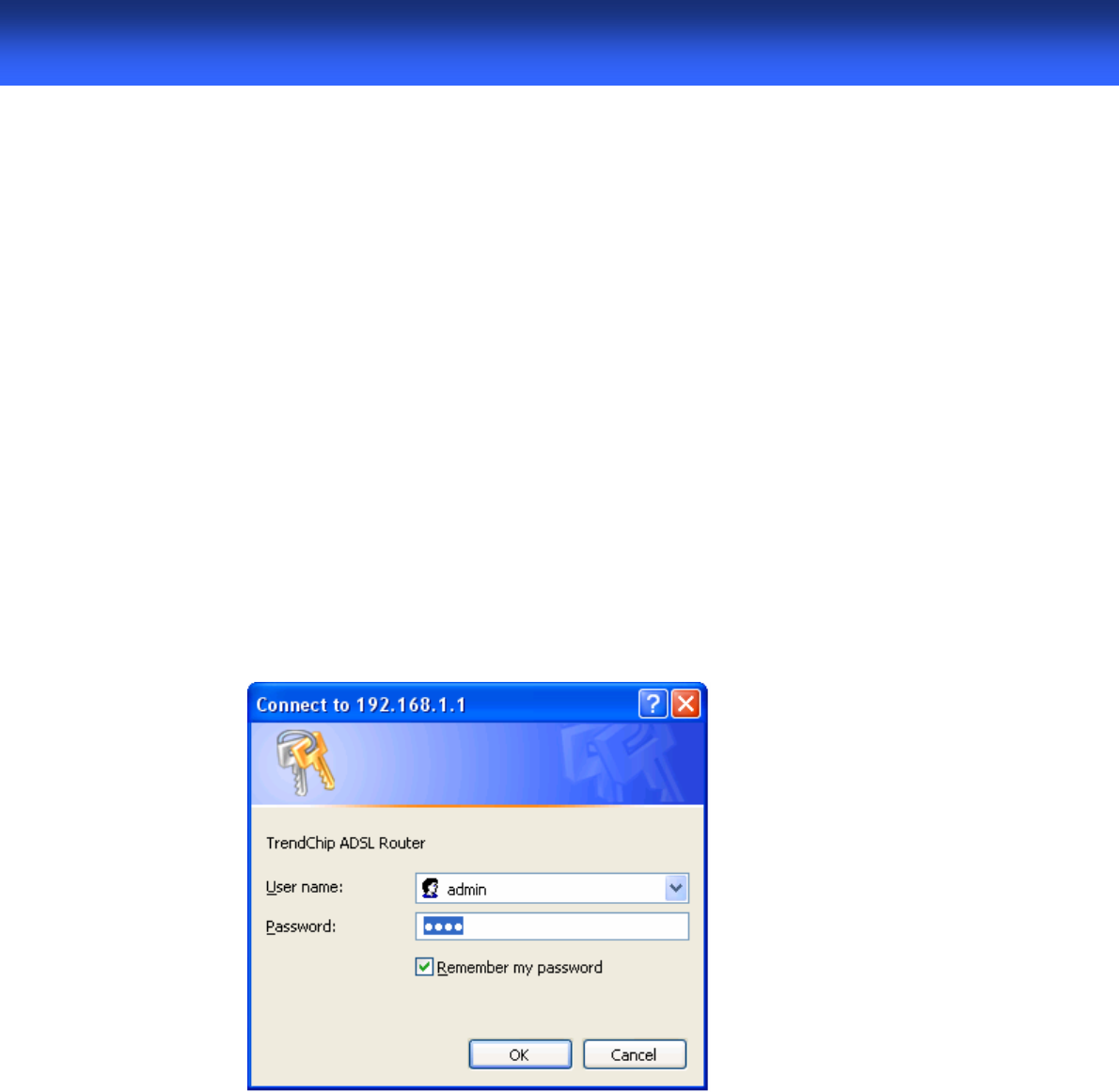
23
WLAN ADSL2+ Route
r
8.0 Introduction of the Web Configuration
8.1 Web Configuration Overview
The embedded web configuration allows you to manage WLAN ADSL2+
Router from anywhere through a browser such as Microsoft Internet Explorer
or Netscape Navigator. Use Internet Explorer 6.0 and later or Netscape
Navigator 7.0 and later versions with JavaScript enabled. It is recommended
that you set your screen resolution to 1024 by 768 pixels
8.2 Accessing WLAN ADSL2+ Router Web Configuration
Step 1. Make sure your WLAN ADSL2+ Router is properly connected
Step 2. Prepare your computer/computer network to connect to the Router
Step 3. Launch your web browser.
Step 4. Type "192.168.1.1" .
Step 5. An Enter Network Password window displays. Enter the user name
(“admin” is the default), password (“1234” is the default) and click OK.
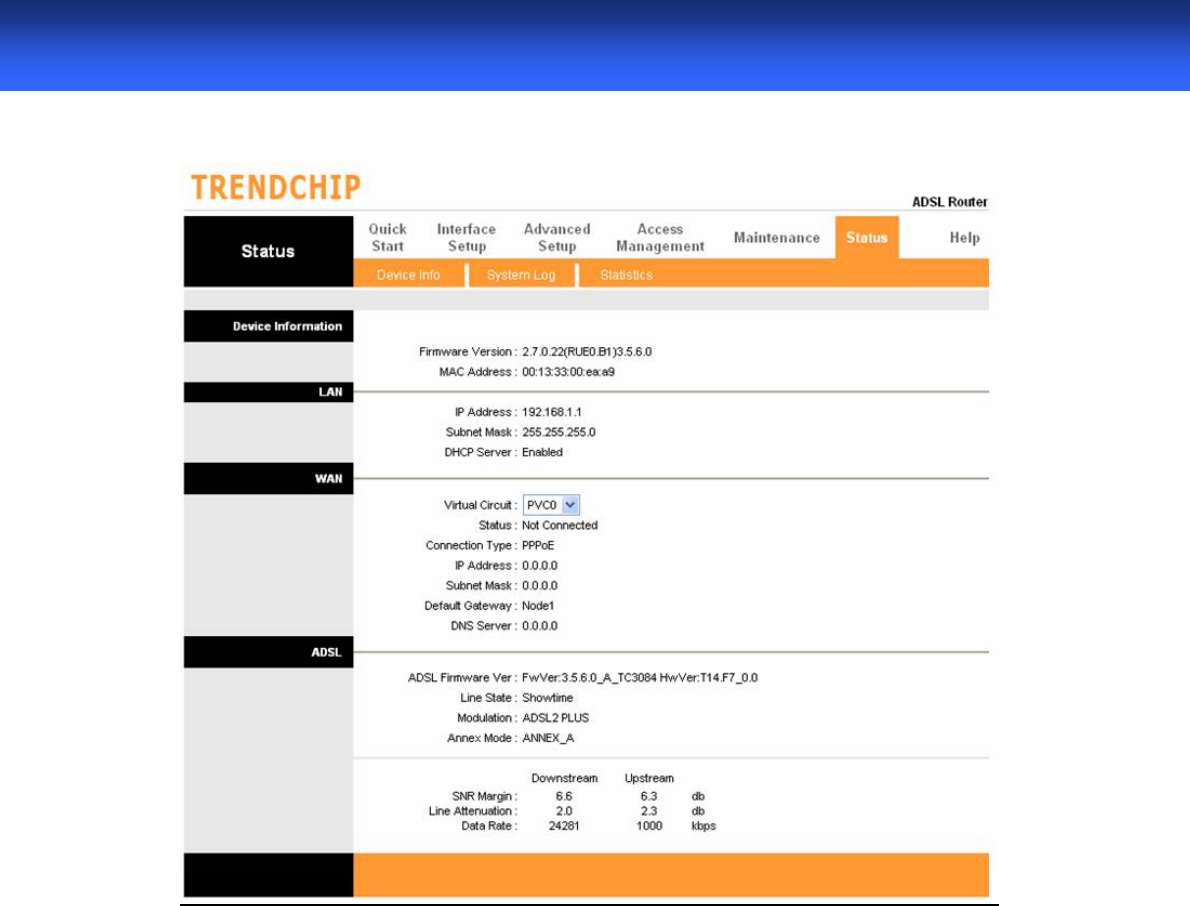
24
WLAN ADSL2+ Route
r
Step 6. You should now see the Site Map screen.
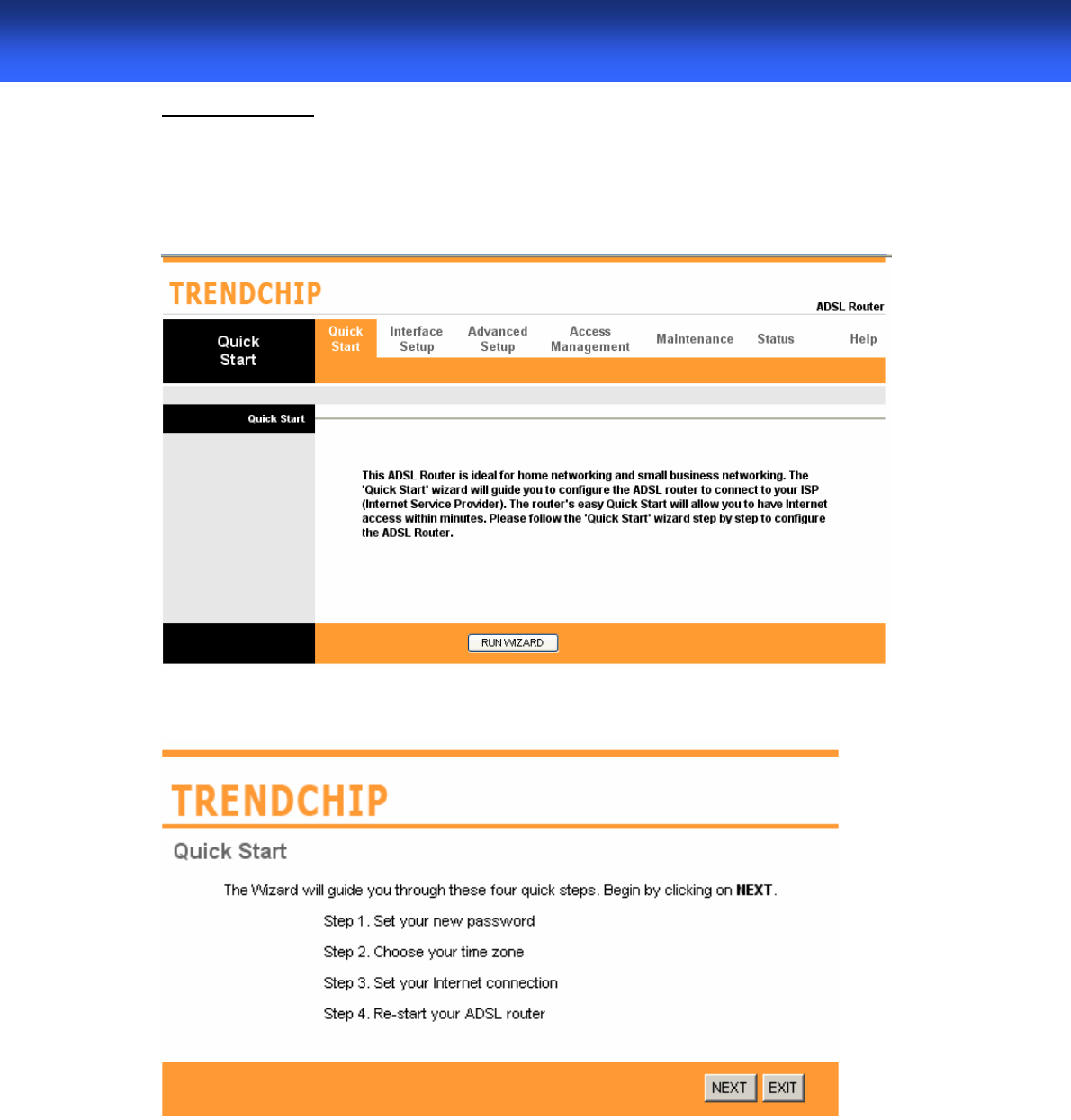
25
WLAN ADSL2+ Route
r
Quick Start Guide
You can use "Quick Start" to setup the router as follows, and the router will connect to the
Internet via ADSL line.
Click "Quick Start" to get into the quick setup procedures.
Click "RUN WIZARD" to start up this procedure.
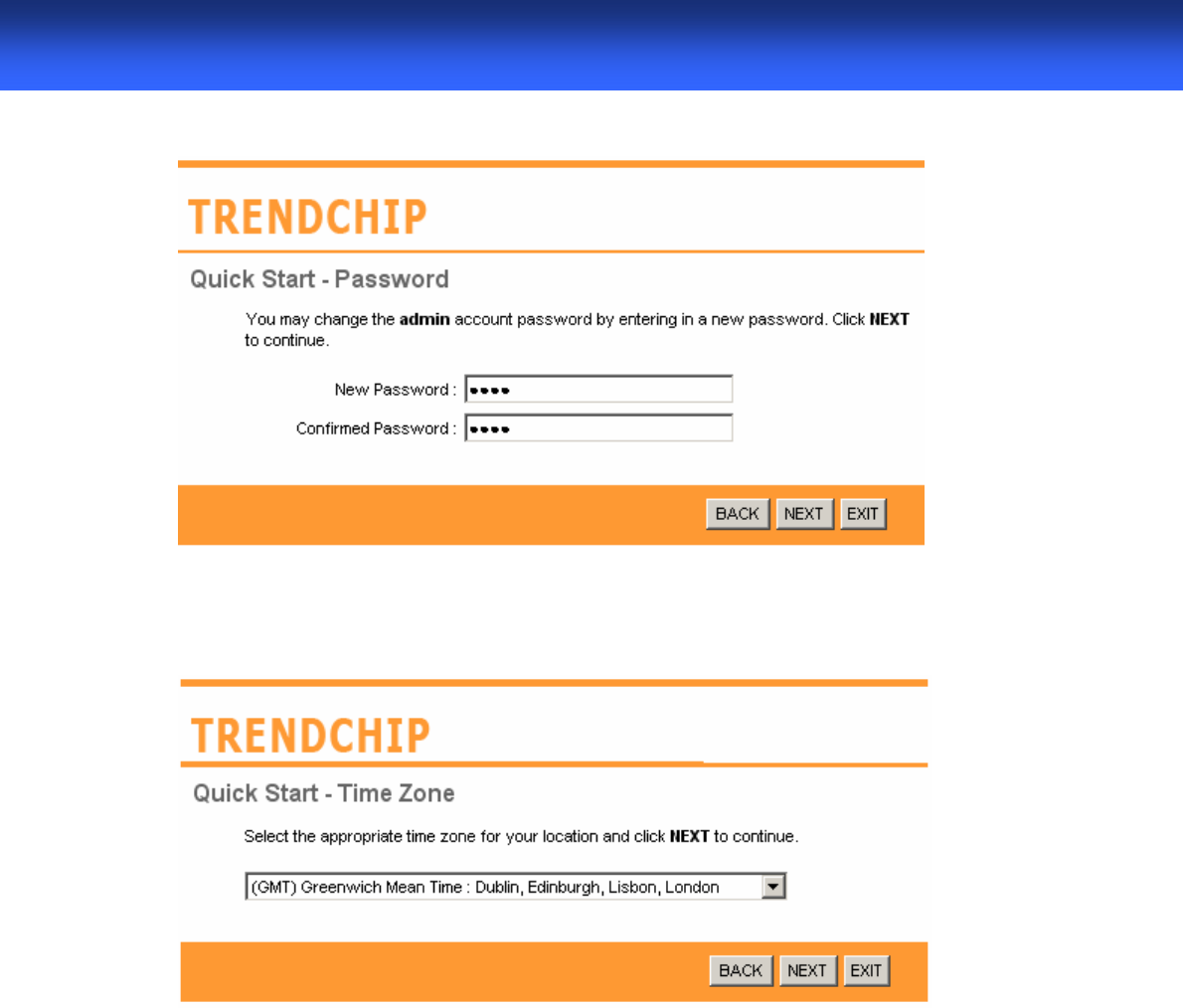
26
WLAN ADSL2+ Route
r
Step 1 – Please click "Next" to setup your new administrator's password.
Step 2 – Please click "Next" to setup your time zone.
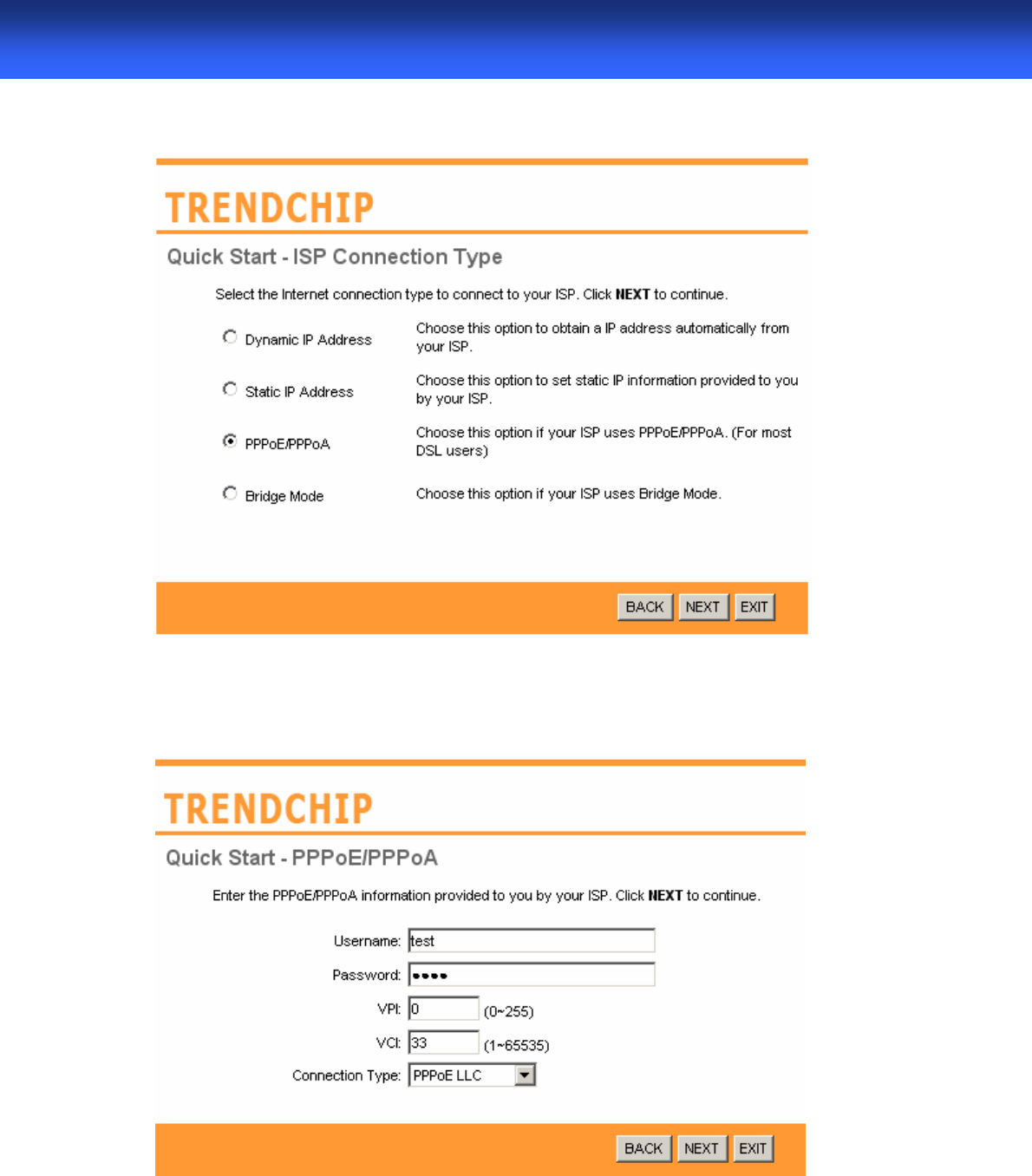
27
WLAN ADSL2+ Route
r
Step 3 – Please click "Next" to setup your Internet connection type. You can have this
information from your Internet Service Provider.
Step 4 - Enter the connection information provided by your ISP and click “Next “.
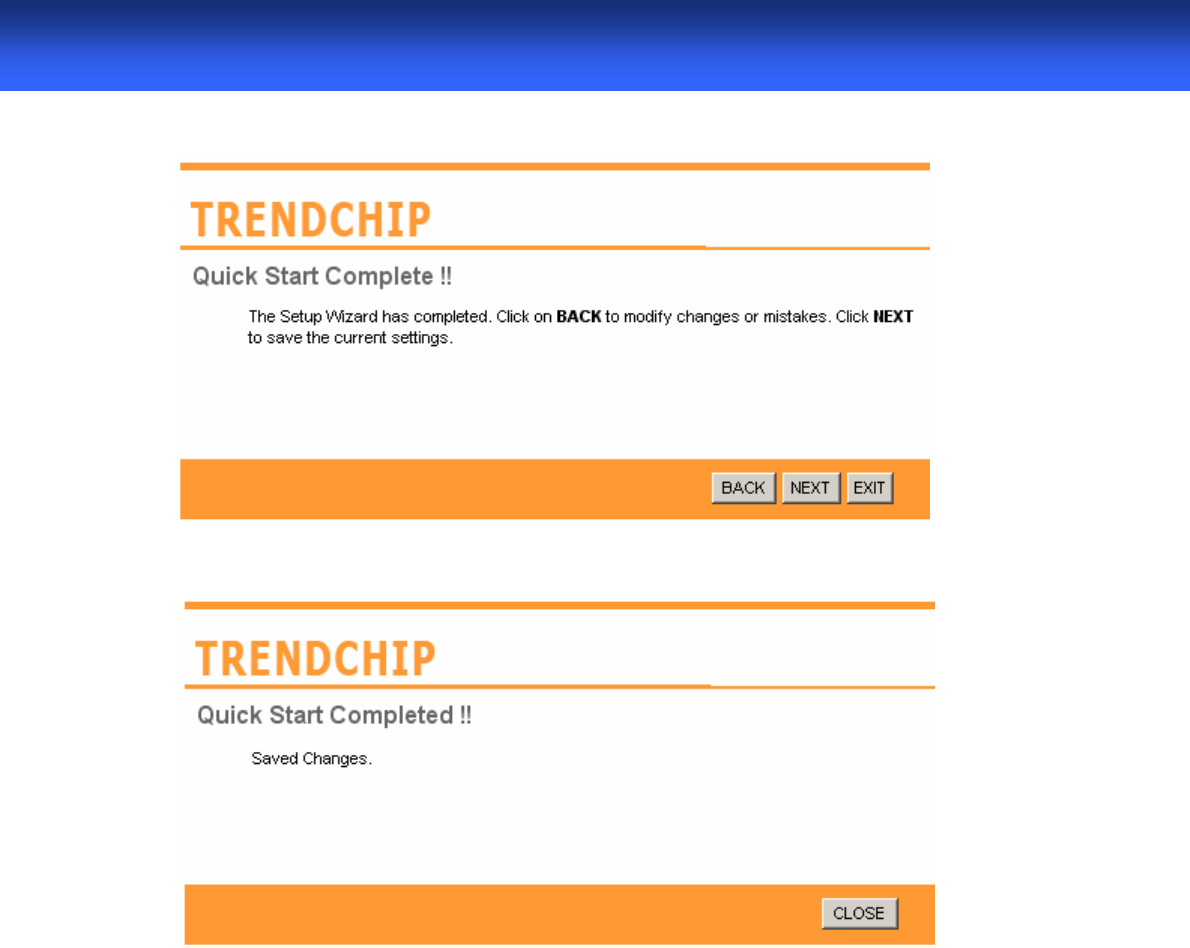
28
WLAN ADSL2+ Route
r
Step 5 - Enter the connection information provided by your ISP and click “Next “.
Step 6 – Please click “CLOSE “ to finish Quick Start.
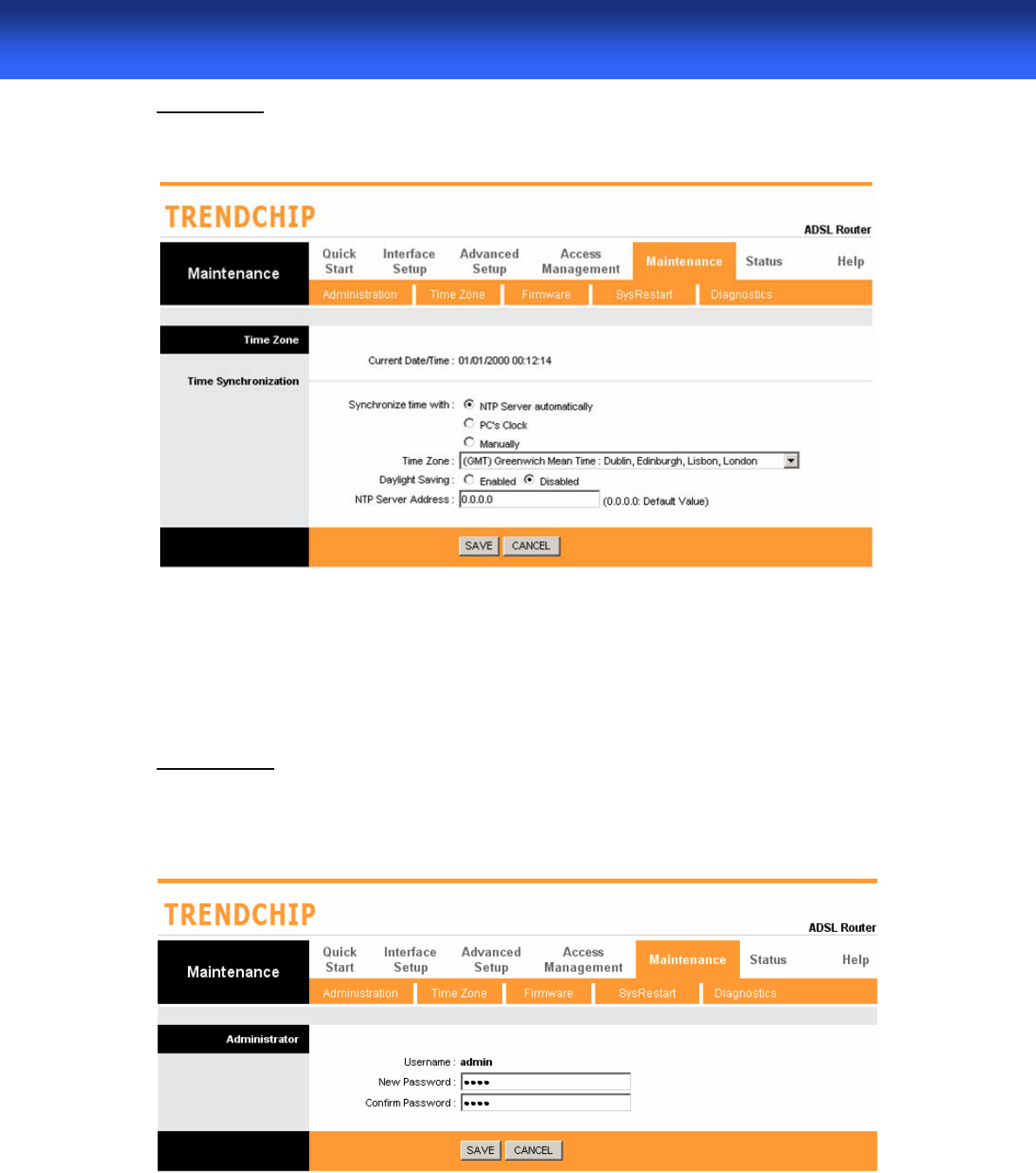
29
WLAN ADSL2+ Route
r
System Time
Go to Maintenance->Time Zone and select system time as you wish.
Connecting to a Simple Network Time Protocol (SNTP) server allows the router to synchronize
the system clock to the global Internet.
The synchronized clock in the router is used to recorded the security log and control client
filtering.
Admin Setting
Go to Maintenance-> Administration to set a new username and password to restrict
management access to the router.
The default is admin (Username) and 1234 (Password)
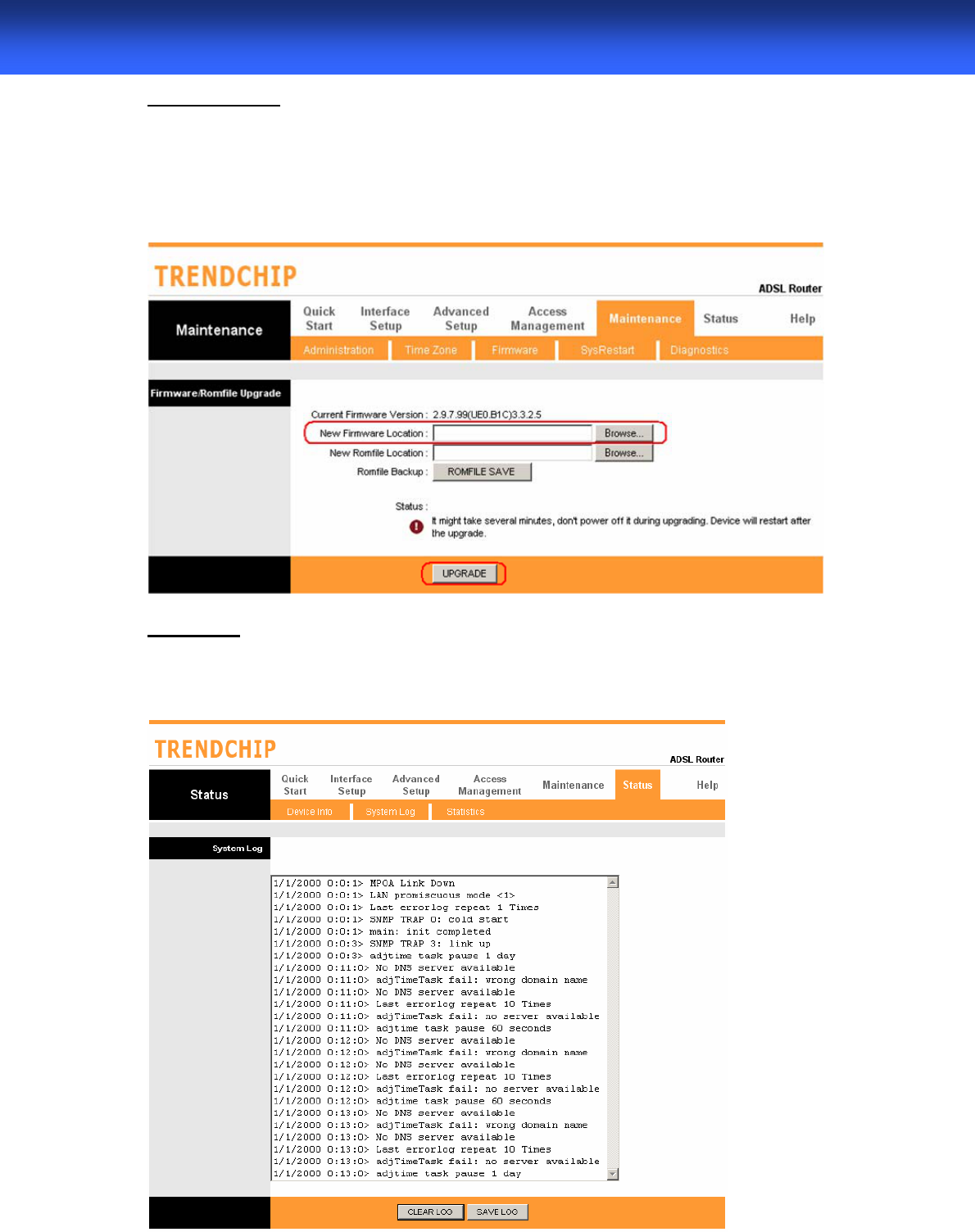
30
WLAN ADSL2+ Route
r
Firmware Update
Go to Maintenance -> Firmware to upgrade the firmware. The new firmware
for your router can improve functionality and performance.
Enter the path and name of the upgrade file then click the UPGRADE button
below. You will be prompted to confirm the upgrade.
System Log
Go to Status -> System Log and you can see the system log file. Click “Save Log” to save
system log file.
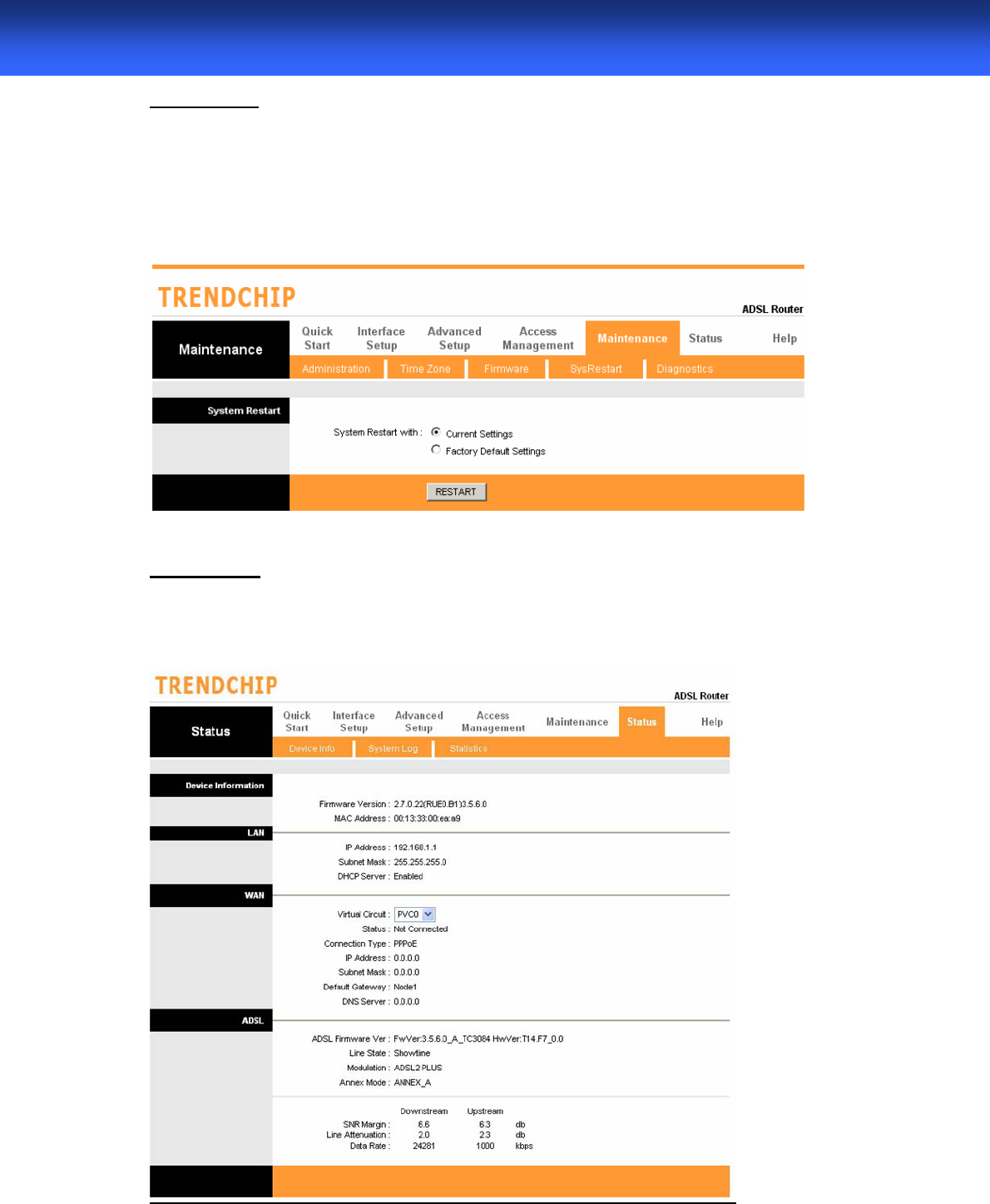
31
WLAN ADSL2+ Route
r
System Reset
Go to Maintenance -> SysRestart to restart your system.In the event that the router stops
responding correctly or in some way stops functioning, you can perform a reset. Your settings
will not be changed. To perform the reset, select "Current Setting" and click on the
"RESTART" button below. The router will reboot with current setting. Select "Factory Default
Setting" and click on the “RESTART” button, the router will reboot with factory default
setting.
ADSL Status
Go to Status->Device Info. The 'ADSL Line Status' enables you to check the status
of your ADSL connection including how fast data is being transferred.
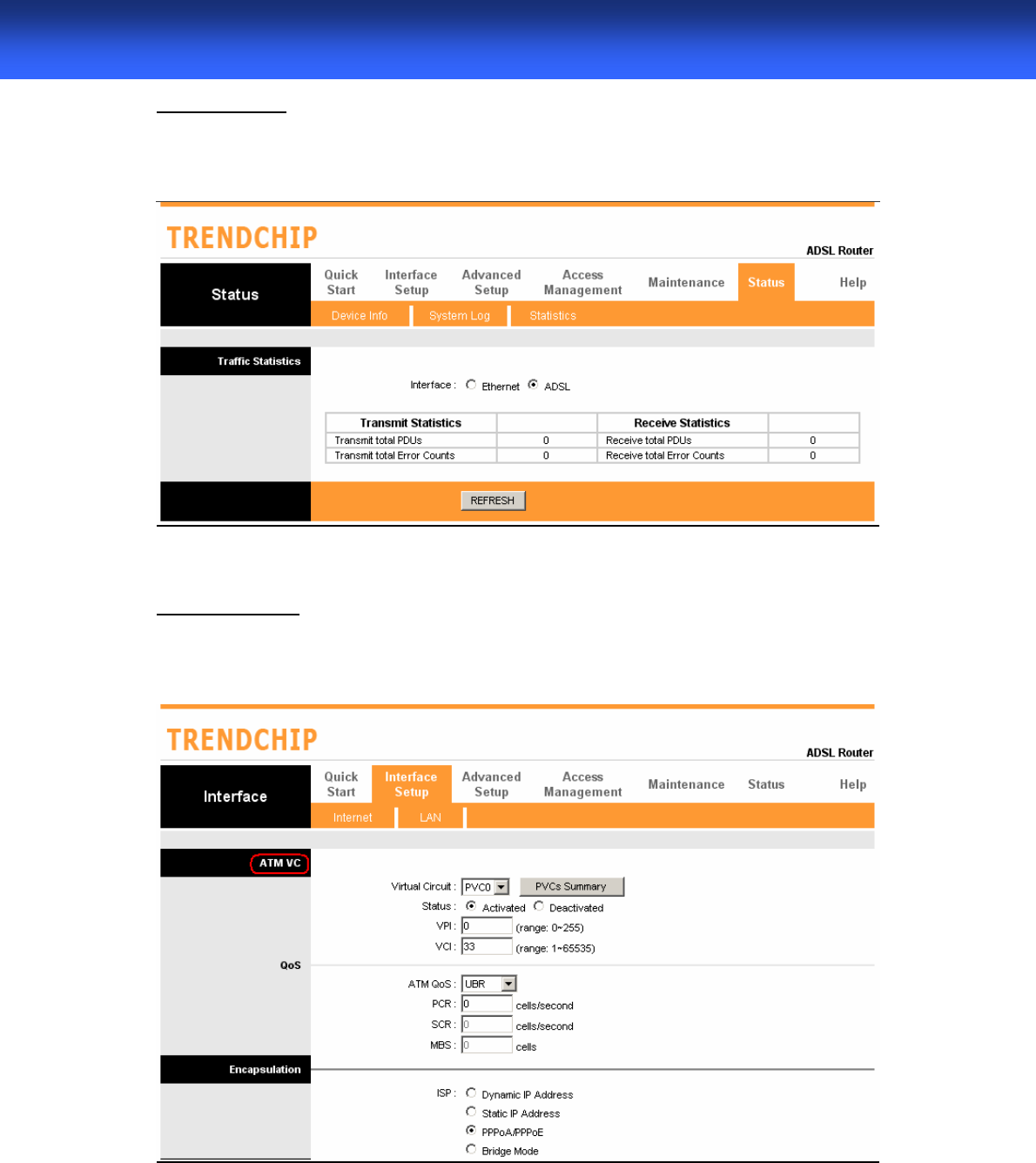
32
WLAN ADSL2+ Route
r
ADSL Statistics
Go to Status-> Statistics and select ADSL interface. You can see the traffic Statistics of
ADSL interface.
VC Configuration
Go to Interface Setup -> Internet. To add or delete ADSL VC configuration, these information
provide by ISP.
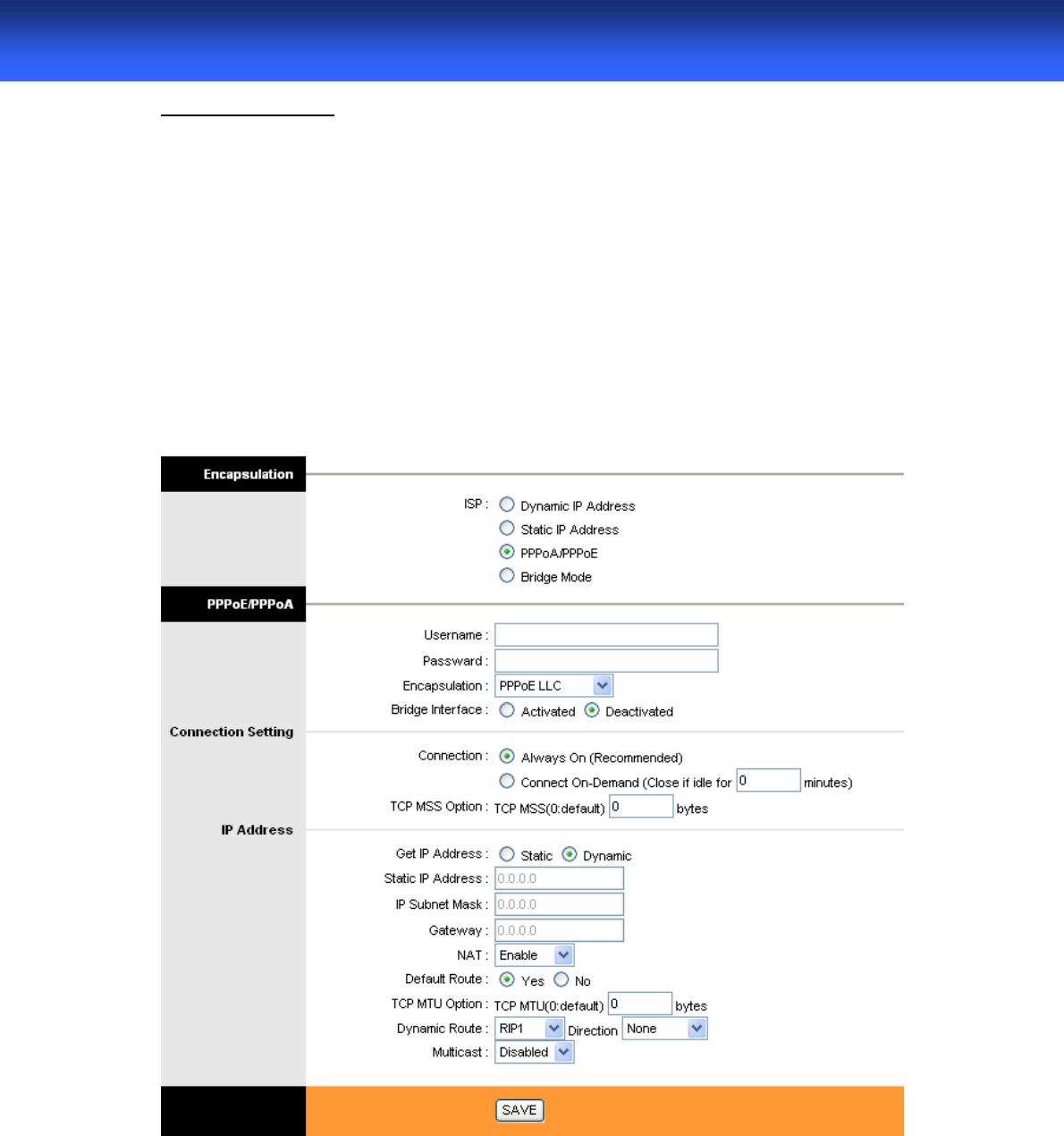
33
WLAN ADSL2+ Route
r
WAN Configuration
Go to Interface Setup -> Internet. The router can be connected to your service provider in
any of the following ways.
Dynamic IP Address: Obtain an IP address automatically from your service provider.
Static IP Address: Uses a static IP address. Your service provider gives a static IP address to
access Internet services.
PPPoE: PPP over Ethernet is a common connection method used for xDSL
PPPoA: PPP over ATM is a common connection method used for xDSL
Bridge: Bridge mode is a common connection method used for xDSL modem.
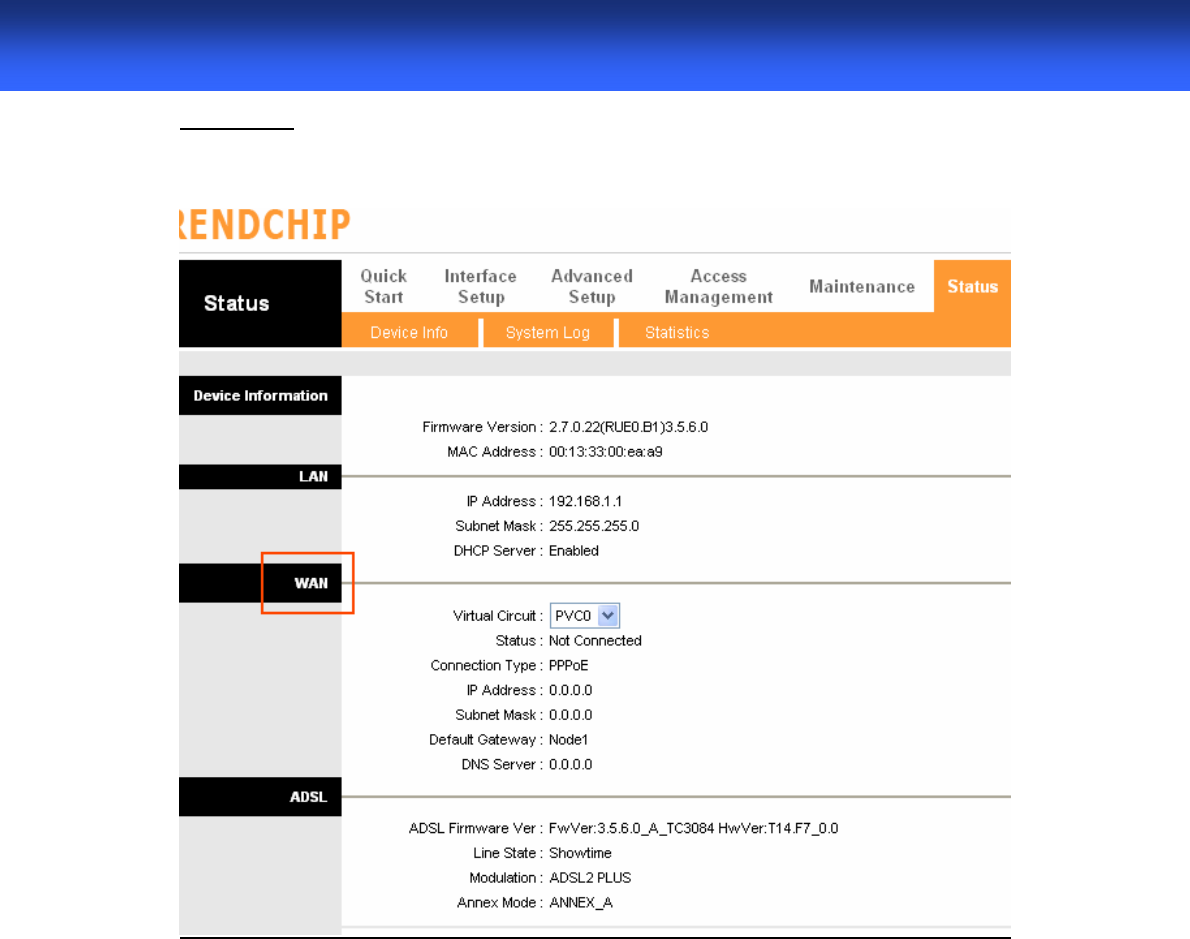
34
WLAN ADSL2+ Route
r
WAN Status
Go to Status -> Device Info and select the Virtual Circuit to see the connection status.

35
WLAN ADSL2+ Route
r
DNS
Go to Interface -> LAN to enable DHCP server. Then you can set DNS server for the router. A
Domain Name system (DNS) server is like an index of IP addresses
and Web addresses. If you type a Web address into you browser, a DNS server will find that
name in its index and find the matching IP address.
Most ISPs provide a DNS server for speed and convenience. Since your Service Provider
many connect to the Internet with dynamic IP settings, it is likely that the
DNS server IP addresses are also provided dynamically. However, if there is a DNS server that
you would rather use, you need to specify the IP address below.
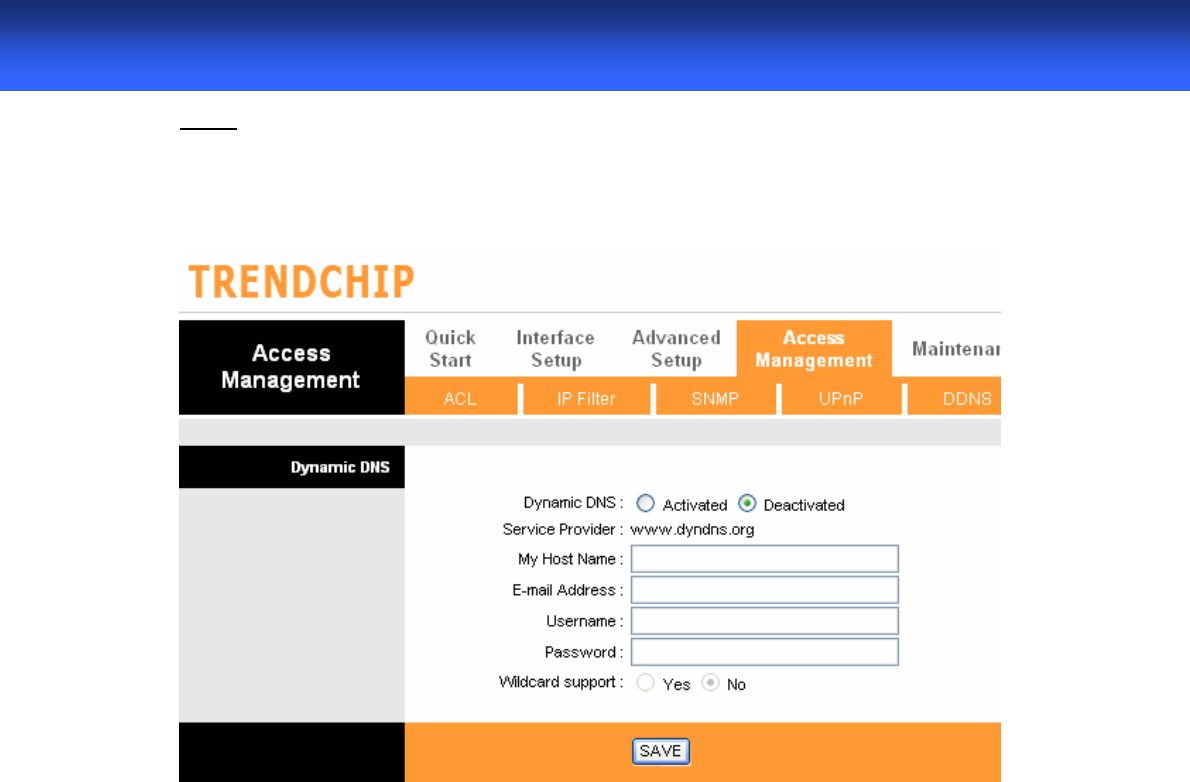
36
WLAN ADSL2+ Route
r
DDNS
Go to Access Management -> DDNS to setup your DDNS parameters. Dynamic DNS allows
you to update your dynamic IP address with one or many dynamic DNS services. So anyone
can access your FTP or Web service on your computer using DNS-like address.
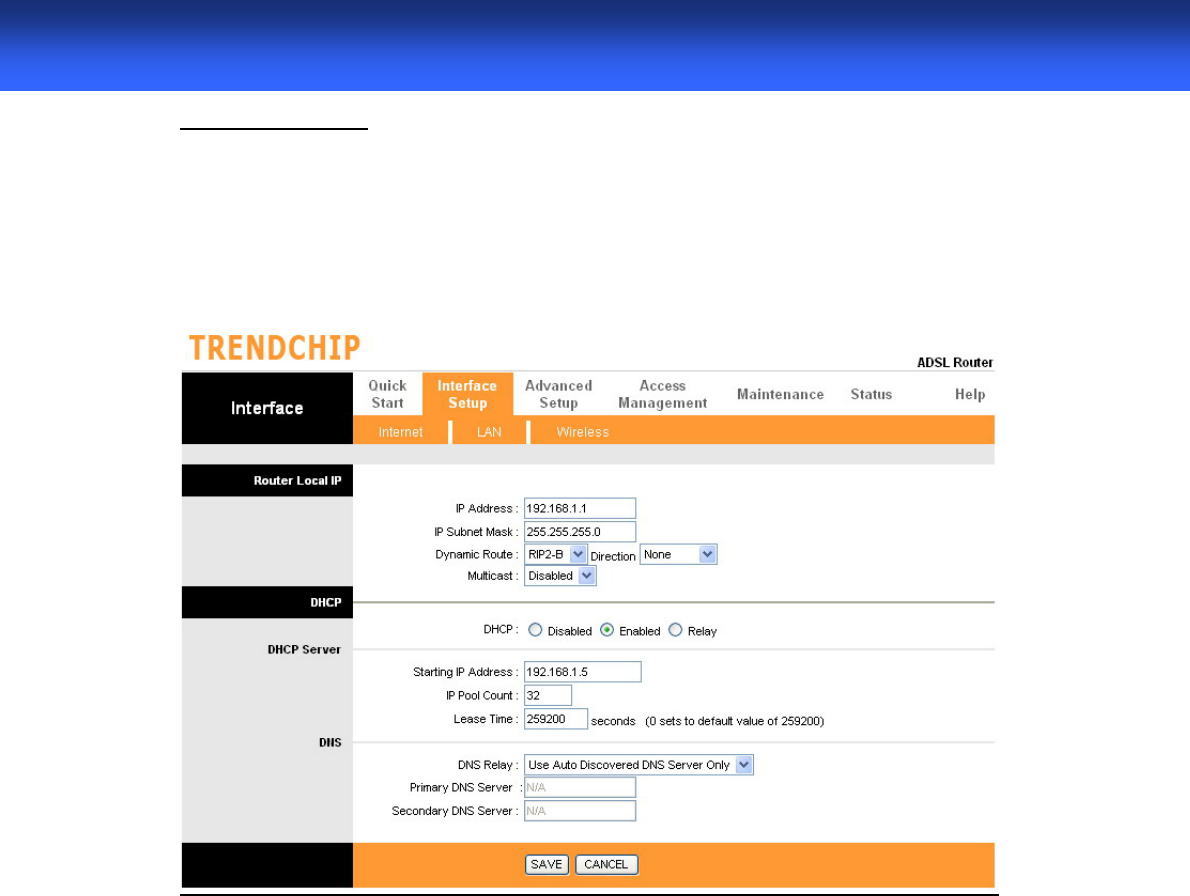
37
WLAN ADSL2+ Route
r
LAN Configuration
Go to Interface Setup -> LAN. The 'LAN Settings' option enables you to configure the LAN
port.
If the DHCP Relay is selected, the DHCP requests from local PCs are forward to the DHCP
server runs on WAN side. To have this function working properly,
disable the NAT to run on router mode only, disable the DHCP server on the LAN port, and
make sure the routing table has the correct routing entry.
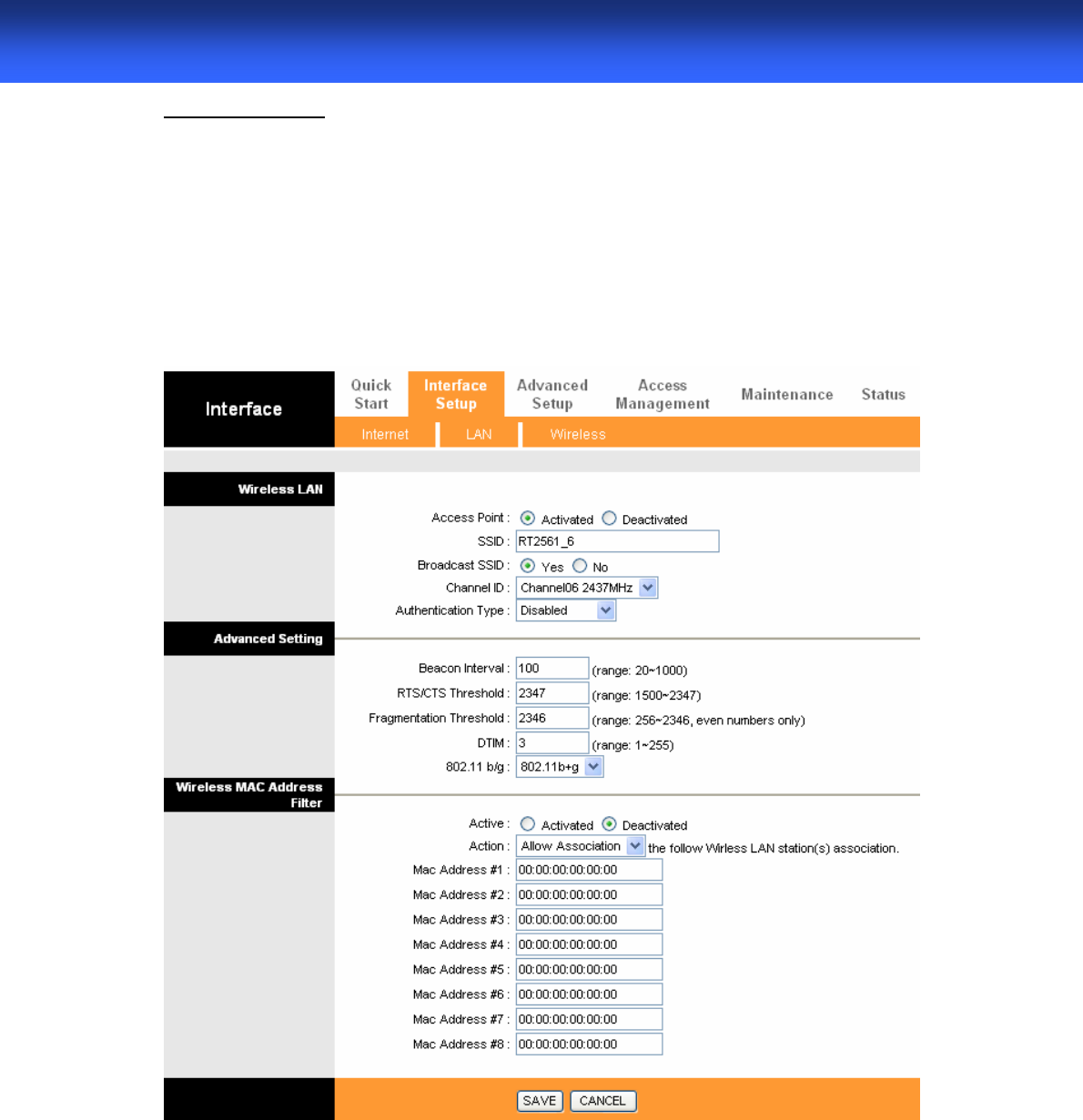
38
WLAN ADSL2+ Route
r
Wireless Settings
Go to Interface -> Wireless to setup the wireless parameters.
SSID
The identifier for the network. You can change the SSID. Only devices with the same SSID can
interconnect.
Channel ID
The channel number is used for wireless networking. The channel setting of the wireless
devices within a network should be the same.
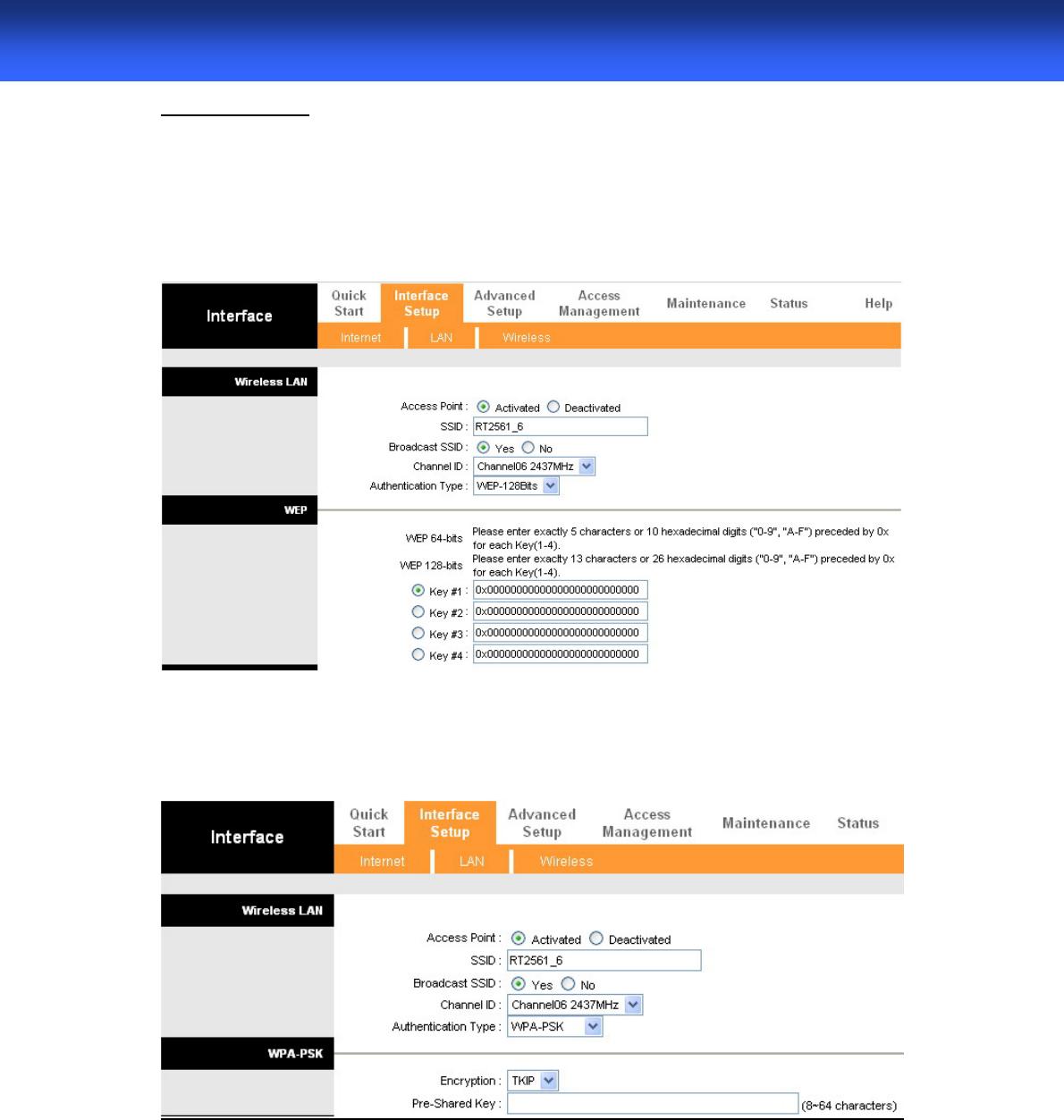
39
WLAN ADSL2+ Route
r
Wireless Security
Go to Interface -> Wireless to setup the wireless security.
The Authentication type supports “shared key WEP 64bits", "shared key WEP 128bits”,
“WPA-PSK”.
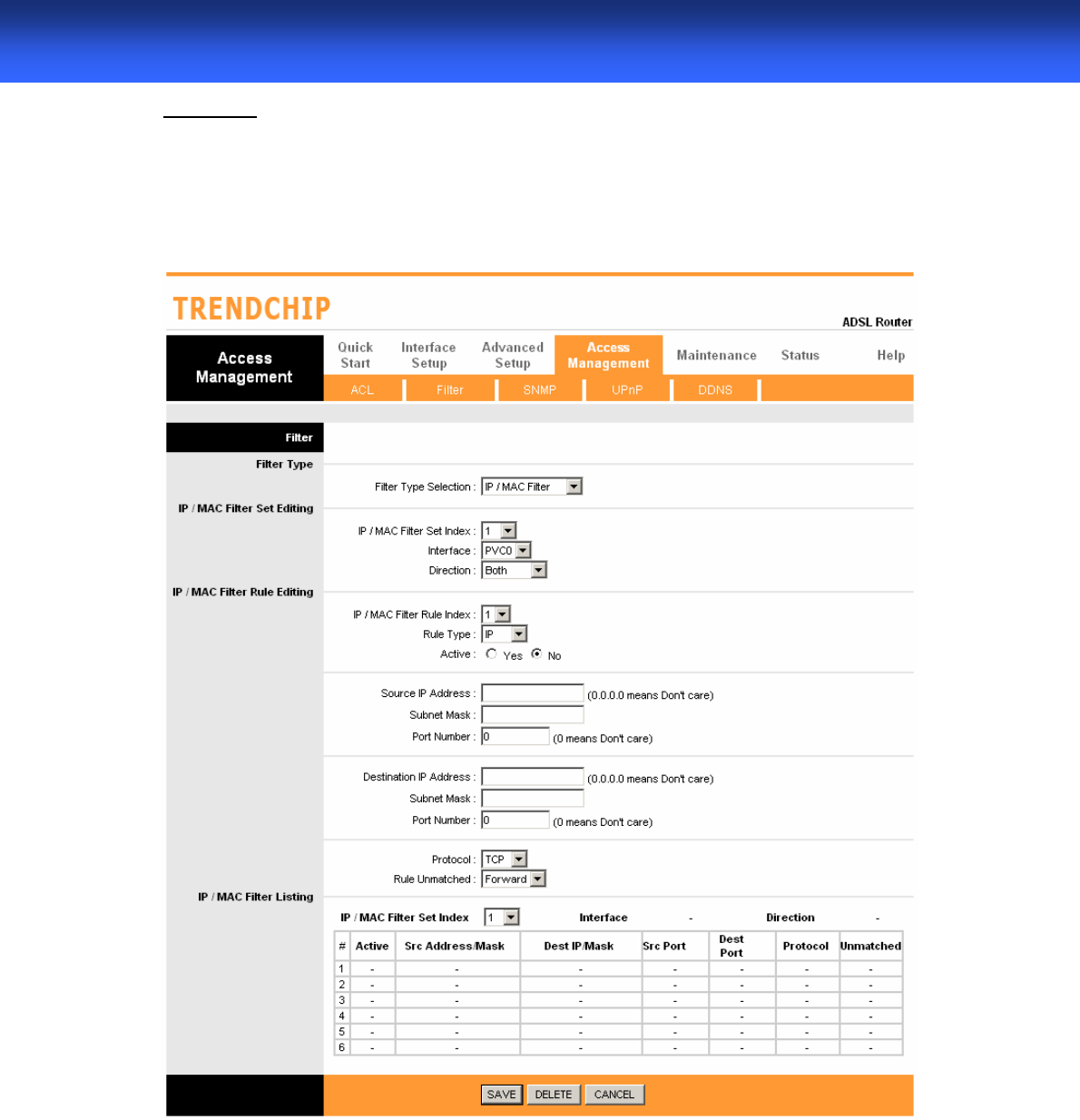
40
WLAN ADSL2+ Route
r
IP Filtering
Go to Access Management -> IP Filtering to block some packets form WAN.The router
provides extensive firewall protection by restricting connection parameters to limit the risk of
intrusion and defending against a wide array of common hacker attacks. The user can set
different IP filter rules of a given protocol (TCP, UDP or ICMP) and a specific direction
(incoming, outgoing, or both) to filter the packets.
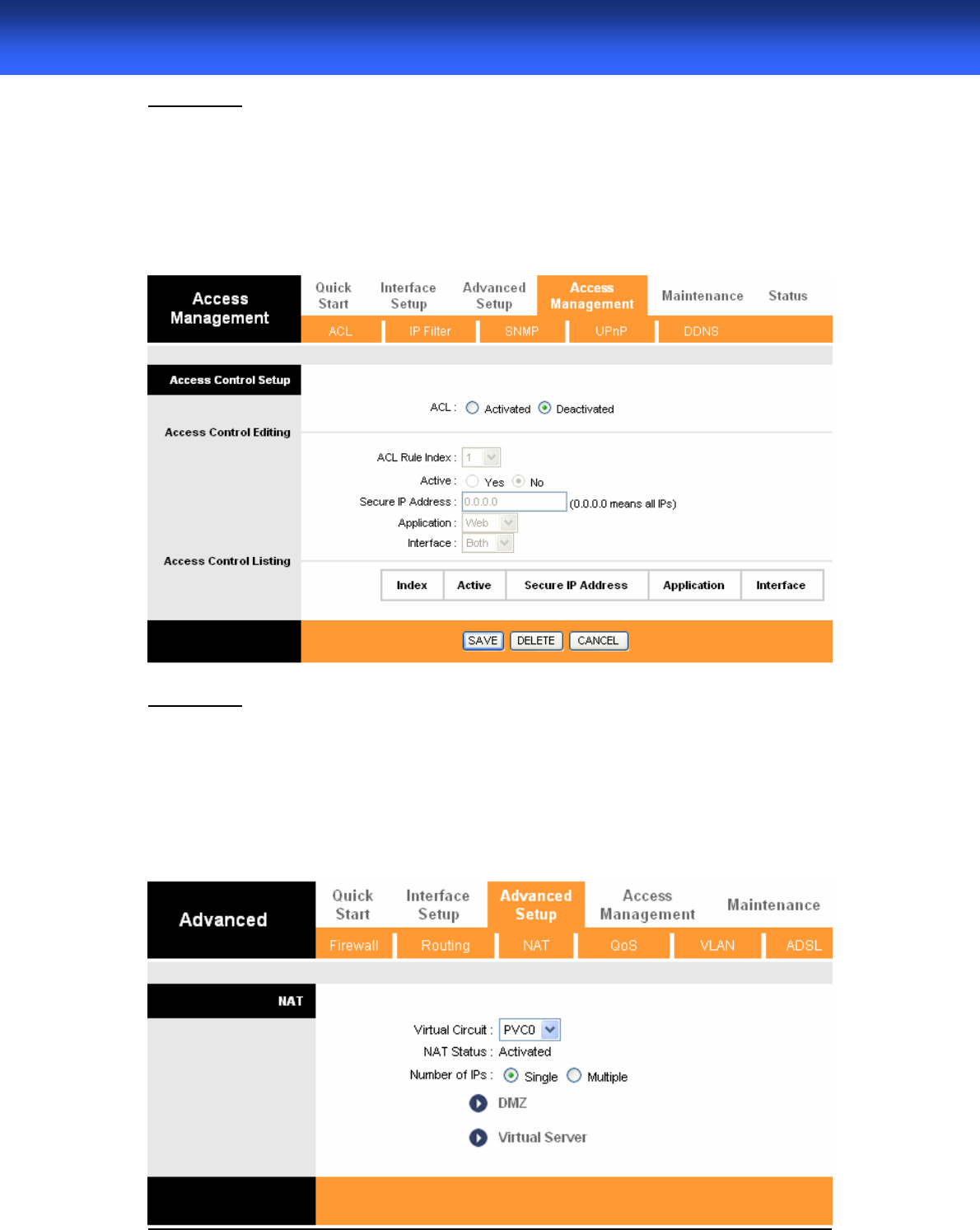
41
WLAN ADSL2+ Route
r
ACL Setting
Go to Access Management -> ACL to enable remote management. The user may remotely
access the WLAN ADSL2+ Router once setting his IP as a Secure IP Address through
selected applications. With the default IP 0.0.0.0, any client would be allowed to remotely
access the WLAN ADSL2+ Router.
NAT Setting
Go to Advanced Setup->NAT to setup the NAT features. Network Address Translation (NAT)
allows multiple users at your local site to access the Internet through a single public IP address
or multiple public IP addresses. NAT can also prevent hacker attacks by mapping local
addresses to public addresses for key services such as the Web or FTP.
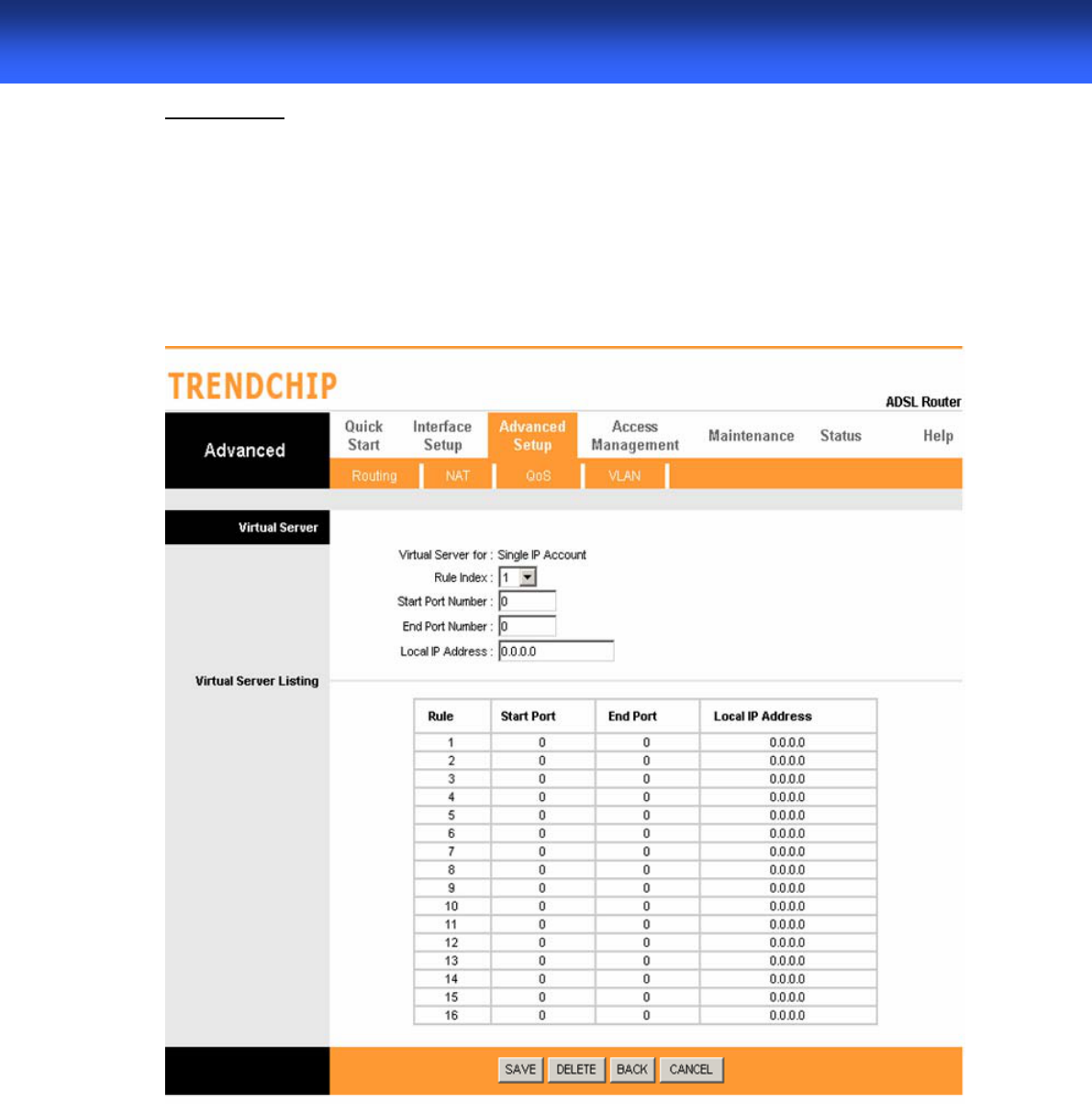
42
WLAN ADSL2+ Route
r
Virtual Server
Go to Advanced Setup ->NAT -> Virtual Server to set virtual server as you need.(known as
Port Mapping).You can configure the router as a virtual server so that remote users accessing
services such as the Web or FTP at your local site via public IP addresses can be
automatically redirected to local servers configured with private IP addresses. In other words,
depending on the requested service (TCP/UDP port numbers), the router redirects the external
service request to the appropriate server (located at another internal IP address). For some
applications, you need to assign a set or a range of ports (example 4000-5000) to a specified
local machine to route the packets. The router allows the user to configure the needed port
mappings to suit such applications.
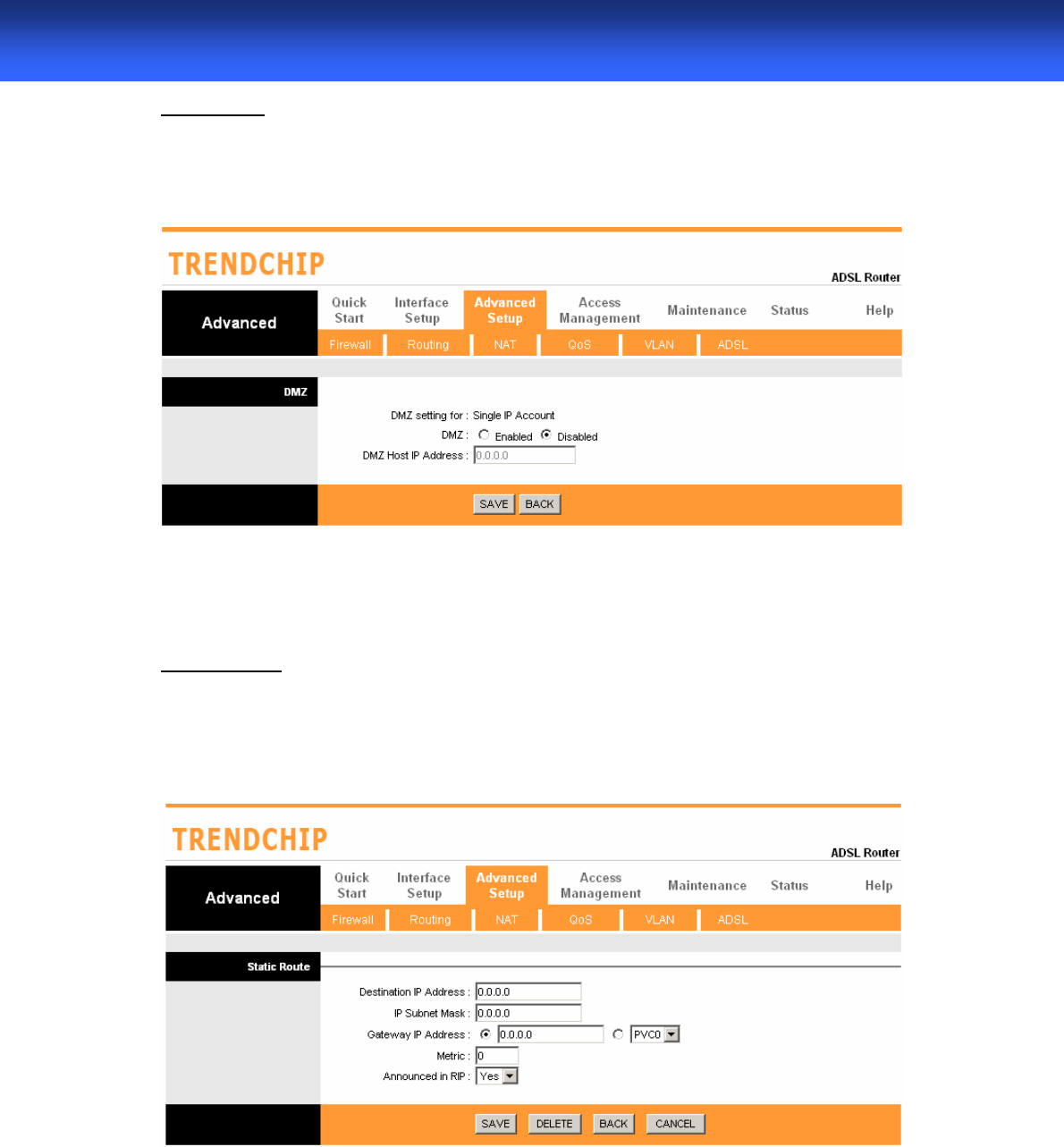
43
WLAN ADSL2+ Route
r
DMZ Setting
Go to Advanced Setup ->NAT -> DMZ to set DMZ parameters. If you have a local client PC
that cannot run an Internet application properly from behind the NAT firewall, you can open the
client up to unrestricted two-way Internet access by defining a virtual DMZ Host.
Static Routing
Go to Advance Setup -> Routing ->Add to setup static route features.
The static routing function determines the path that router follows over your network before
and after it passes through your router. You can use static routing to allow different IP domain
users to access the Internet through this device.
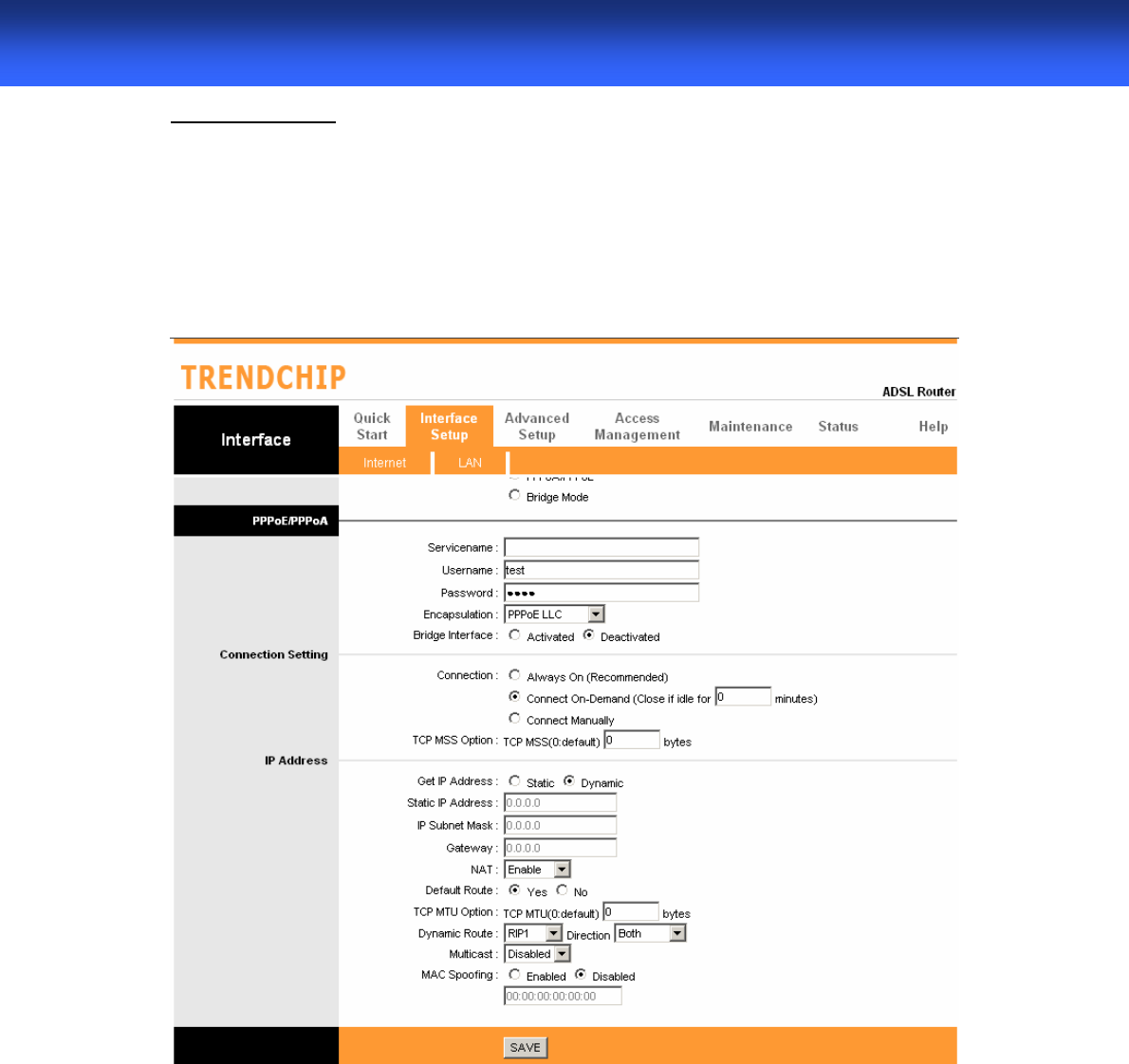
44
WLAN ADSL2+ Route
r
Dynamic Routing
Go to Interface Setup -> Internet to select Dynamic Route as you need.
The dynamic routing feature of the router can be used to allow the router to automatically
adjust to physical changes in the network's layout. The router uses the dynamic RIP protocol. It
determines the route that the network packets take based on the fewest number of hops
between the source and the destination. The RIP protocol regularly broadcasts routing
information to other routers on the network.
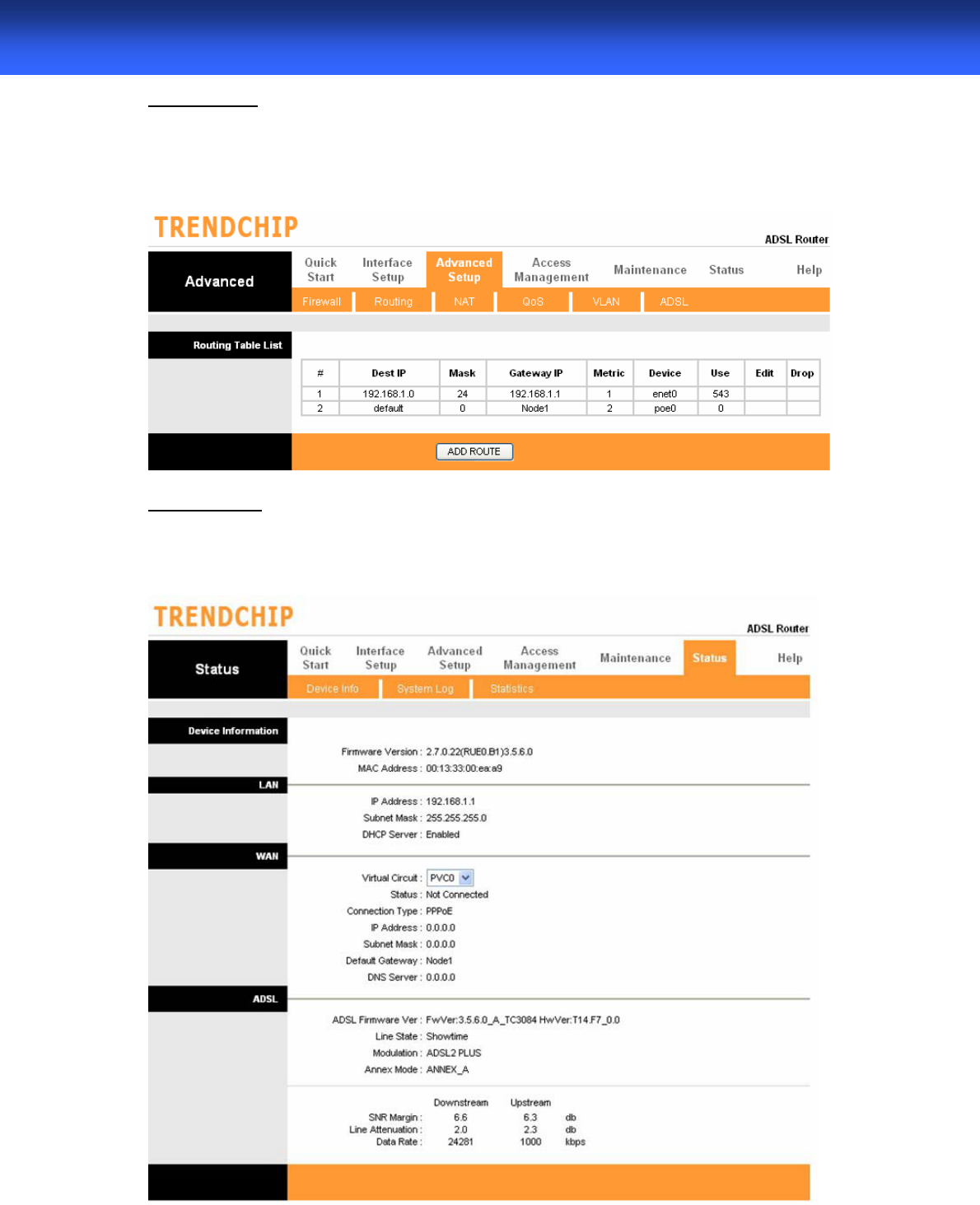
45
WLAN ADSL2+ Route
r
Routing Table
Go to Advanced Setup -> Routing to see the Routing Table.The Routing table allows you to
see how many routings on your routing table and interface information
System Status
Go to Status -> Device Info to see the router's information. The System Status page shows
the WAN, LAN and the router's firmware version.
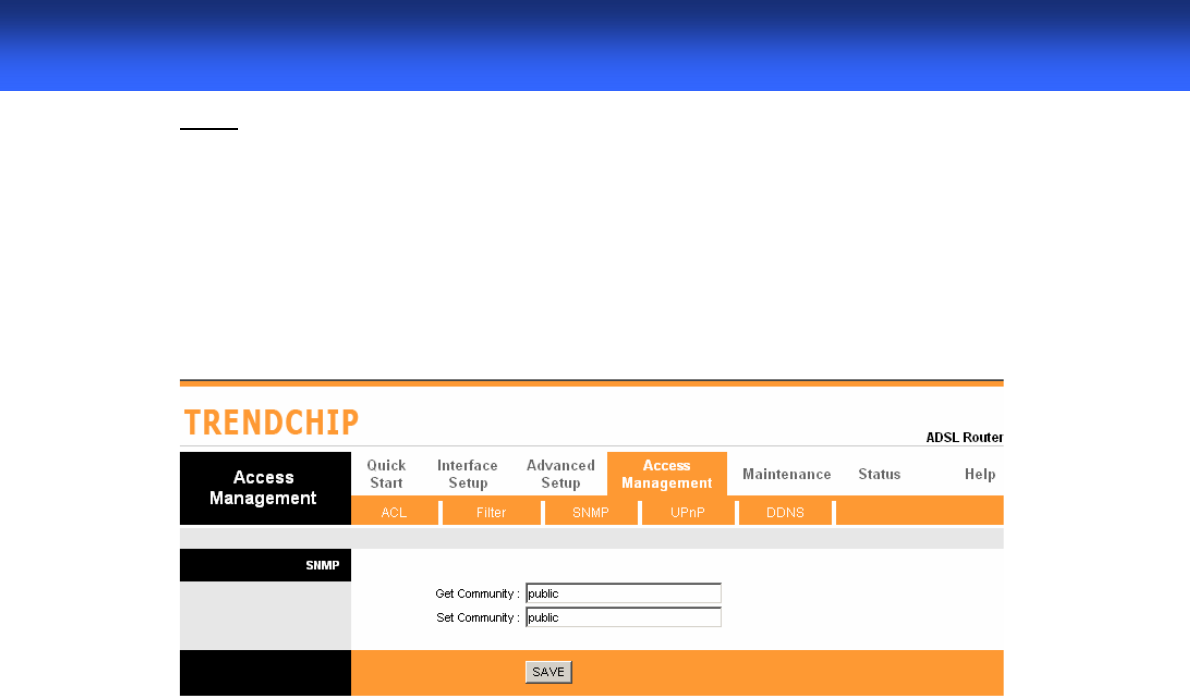
46
WLAN ADSL2+ Route
r
SNMP
Go to Access Management -> SNMP to setup SNMP feature.Simple Network Management
Protocol is used for exchanging information between network device.
Get Community : Select to set the password for the incoming Get- and GetNext requests from
the management station.
Set Community : Select to set the password for incoming Set requests from the management
station.
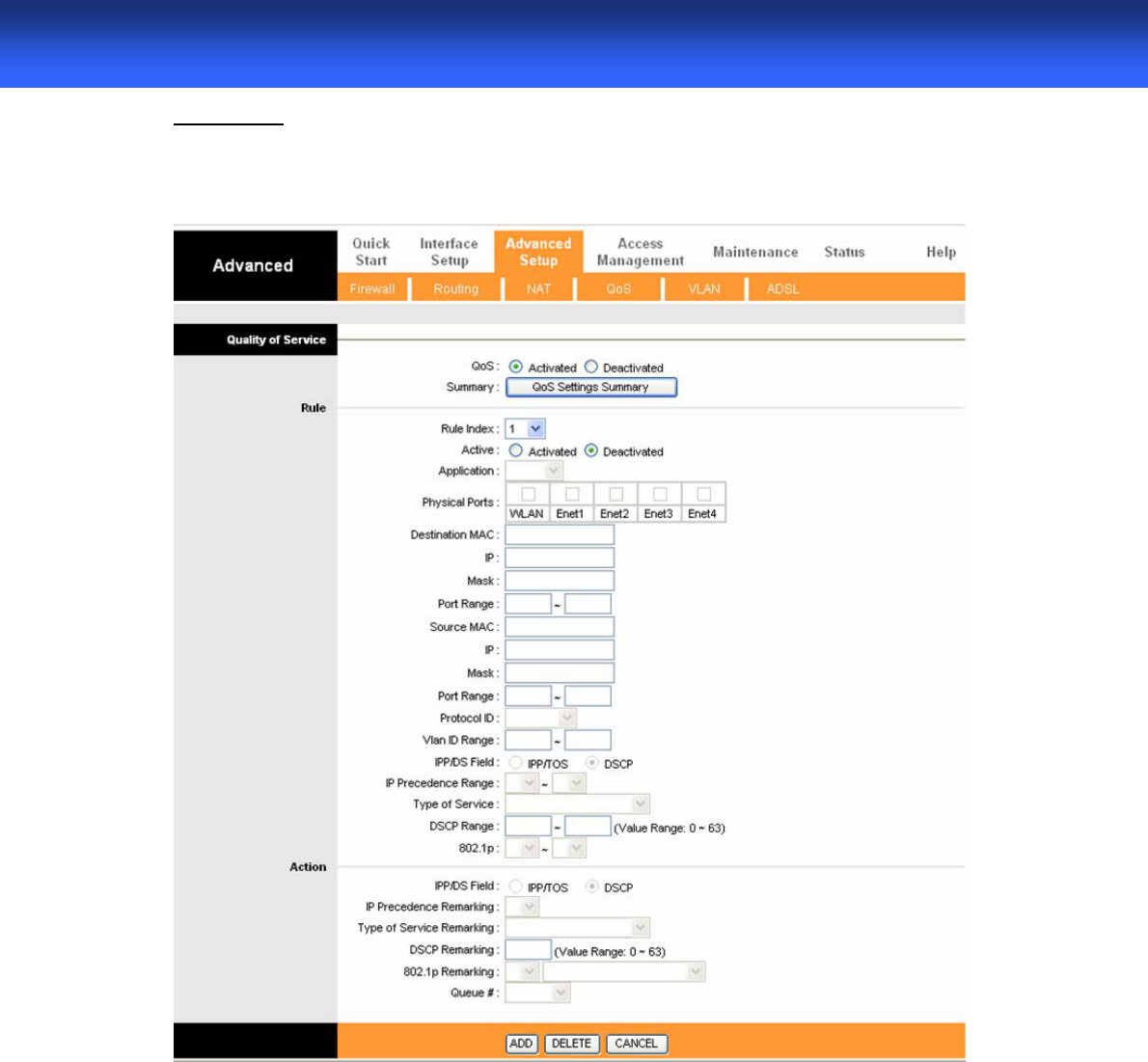
47
WLAN ADSL2+ Route
r
QoS Setting
Go to Advanced Setup -> QoS to setup QoS features. This option will provide better service
of selected network traffic over various technologies.
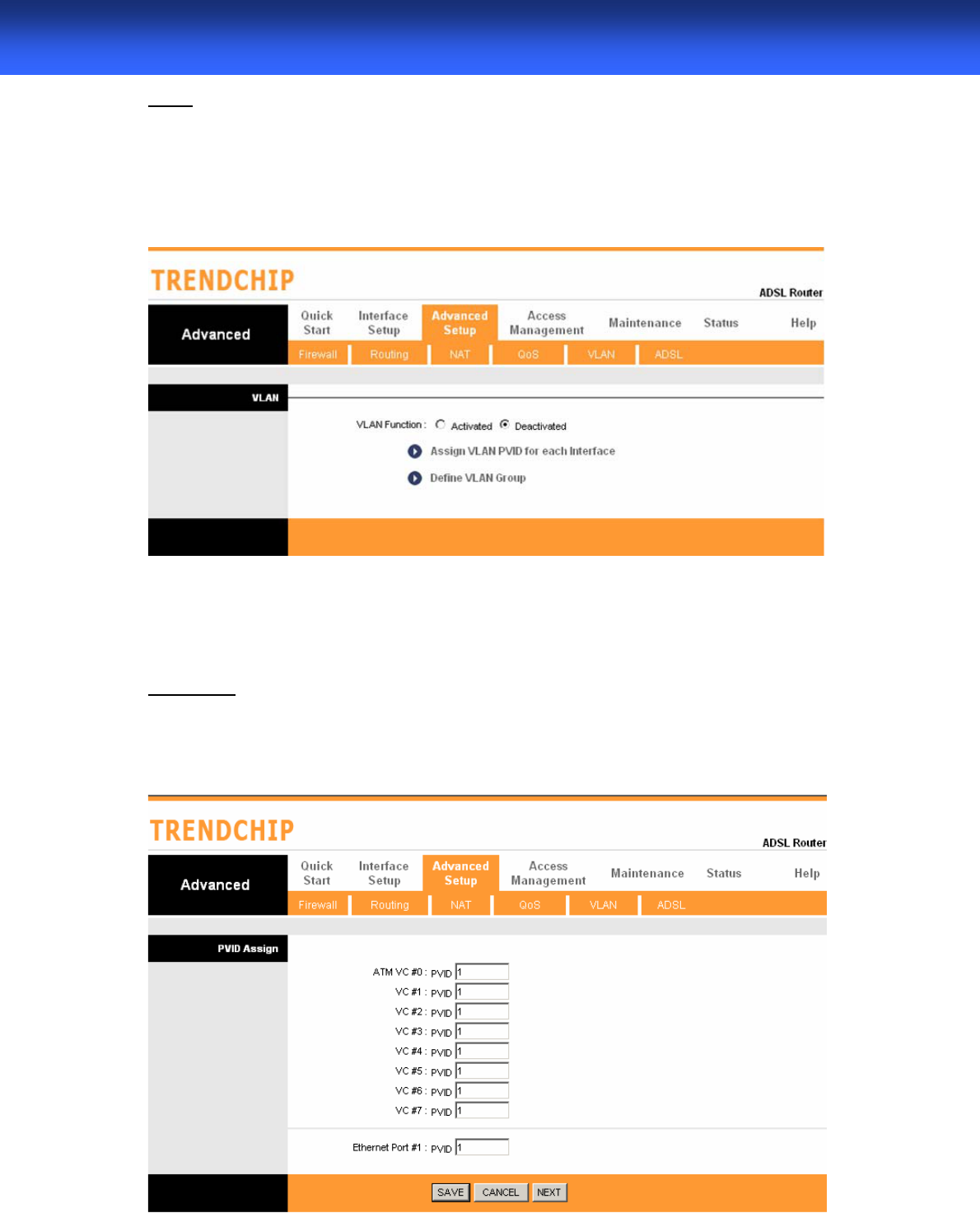
48
WLAN ADSL2+ Route
r
VLAN
Go to Advanced Setup -> VLAN to enable VLAN features. Virtual LAN (VLAN) is a group of
devices on one or more LANs that are configured so that they can communicate as if they
were attached to the same wire, when in fact they are located on a number of different LAN
segments. Because VLANs are based on logical instead of physical connections, it is very
flexible for user/host management, bandwidth allocation and resource optimization..
VLAN PVID
Go to Advanced Setup -> VLAN-> Assign VLAN PVID for each interface to setup VLAN
PVID features. Each physical port has a default VID called PVID (Port VID). PVID is assigned
to untagged frames or priority tagged frames (frames with null (0) VID) received on this port.
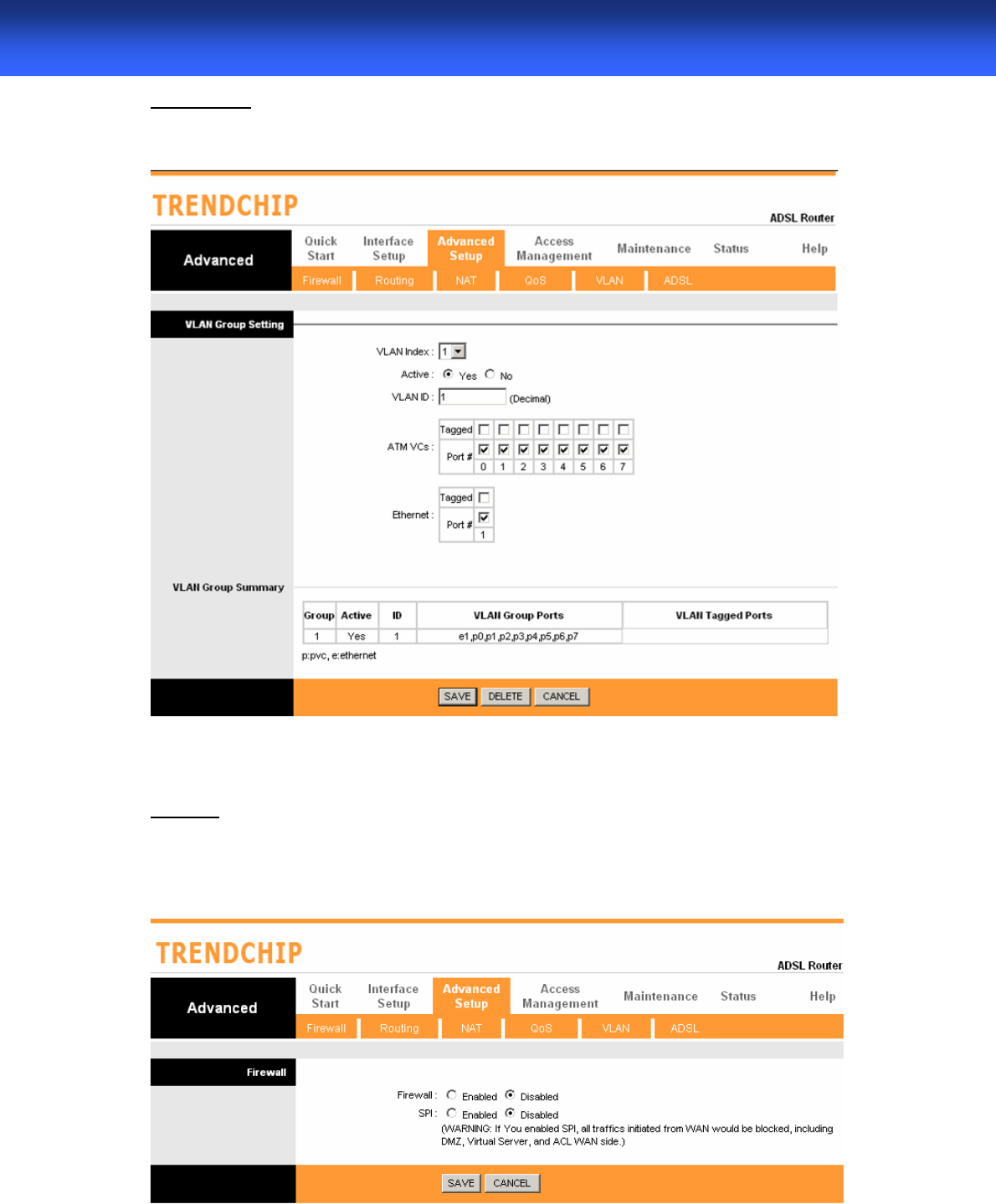
49
WLAN ADSL2+ Route
r
VLAN Group
Go to Advanced Setup -> VLAN-> Define VLAN Group to setup VLAN group features.
Firewall
Go to Advanced Setup ->Firewall to setup Firewall features. Select this option can
automatically detect and block Denial of Service (DoS) attacks, such as Ping of Death, SYN
Flood, Port Scan and Land Attack.

50
WLAN ADSL2+ Route
r
9.0 Universal Plug-and-Play (UPnP)
9.1 Universal Plug and Play Overview
Universal Plug and Play (UPnP) is a distributed, open networking standard that uses TCP/IP
for simple peer-to-peer network connectivity between devices. An UPnP device can
dynamically join a network, obtain an IP address, convey its capabilities and learn about other
devices on the network. In turn, a device can leave a network smoothly and automatically
when it is no longer in use.
9.2 How do I know if I'm using UPnP?
UPnP hardware is identified as an icon in the Network Connections folder (Windows XP). Each
UPnP compatible device installed on your network will appear as a separate icon. Selecting
the icon of a UPnP device will allow you to access the information and properties of that
device.
9.3 NAT Traversal
UPnP NAT traversal automates the process of allowing an application to operate through NAT.
UPnP network devices can automatically configure network addressing, announce their
presence in the network to other UPnP devices and enable exchange of simple product and
service descriptions. NAT traversal allows the following:
¾ Dynamic port mapping
¾ Learning public IP addresses
¾ Assigning lease times to mappings
Windows Messenger is an example of an application that supports NAT traversal and UPnP.
See the Network Address Translation (NAT) chapter for further information about NAT.
9.4 Cautions with UPnP
The automated nature of NAT traversal applications in establishing their own services may
present network security issues. Network information and configuration may also be obtained
and modified by users in some network environments.
All UPnP-enabled devices may communicate freely with each other without additional
configuration. Disable UPnP if this is not your intention.
UPnP broadcasts are only allowed on the LAN.
See later sections for examples of installing UPnP in Windows XP and Windows Me as well as
an example of using UPnP in Windows.

51
WLAN ADSL2+ Route
r
9.5 Configuring UPnP
From the Site Map in the main menu, click UPnP under Access Managemen to display the
screen shown next.
The following table describes the labels in this screen.
LABEL DESCRIPTION
UPnP
Select this checkbox to activate UPnP. Be aware that anyone could use a UPnP
application to open the web configuration's login screen without entering
WLAN ADSL2+ Router's IP address (although you must still enter the password
to access the web configuration).
Auto configured
Select this check box to allow UPnP-enabled applications to automatically
configure WLAN ADSL2+ Router so that they can communicate through WLAN
ADSL2+ Router, for example by using NAT traversal, UPnP applications
automatically reserve a NAT forwarding port in order to communicate with
another UPnP enabled device; this eliminates the need to manually configure
port forwarding for the UPnP enabled application.
Apply Click Apply to save your settings back to home screen.
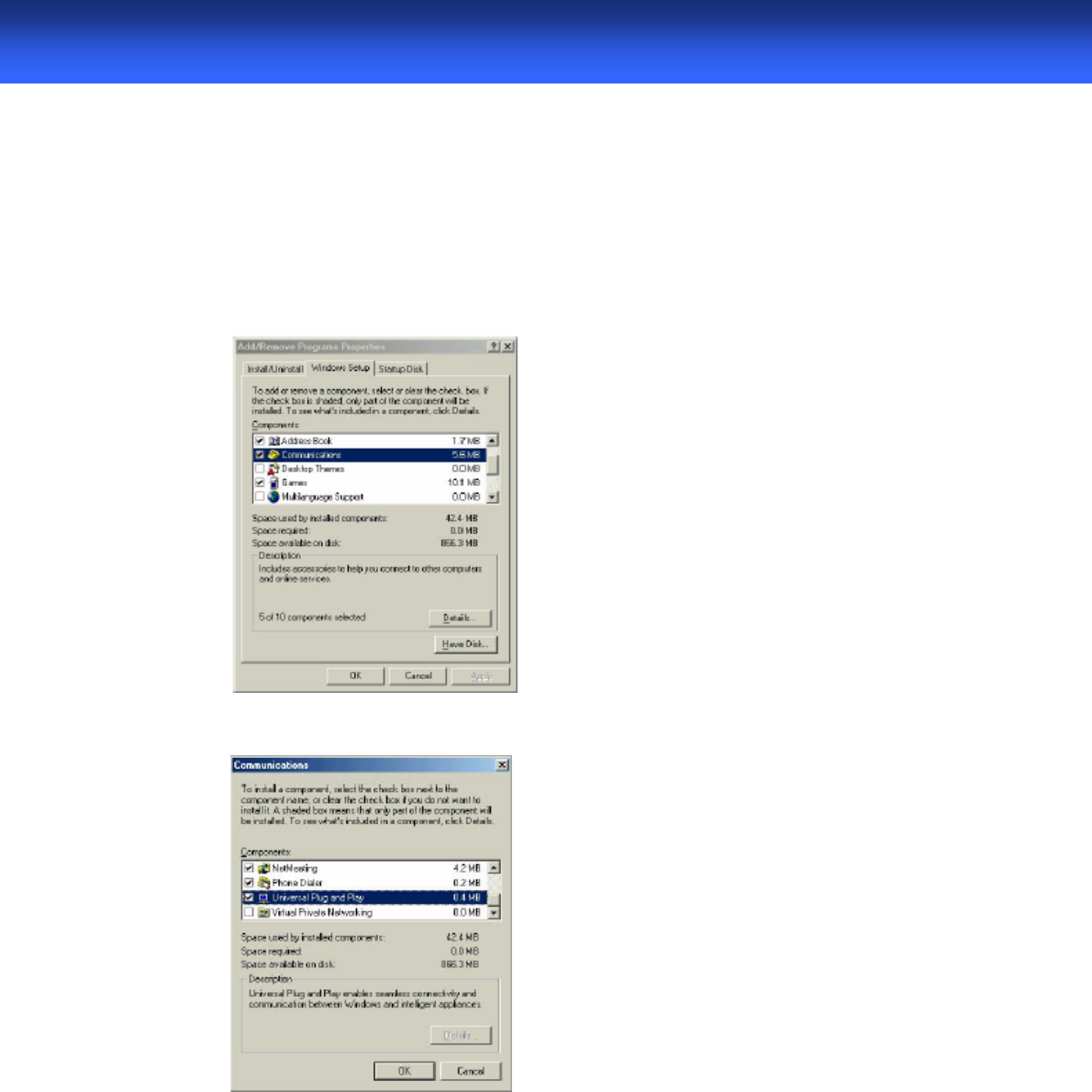
52
WLAN ADSL2+ Route
r
9.6 Installing UPnP in Windows Example
This section shows how to install UPnP in Windows Me and Windows XP.
9.7 Installing UPnP in Windows Me
Follow the steps below to install the UPnP in Windows Me.
Step 1. Click Start and Control Panel. Double-click Add/Remove Programs.
Step 2. Click on the Windows Setup tab and select Communication in the Components
selection box. Click Details.
Step 3. In the Communications window, select the Universal Plug and Play check box in the
Components selection box.
Step 4. Click OK to go back to the Add/Remove Programs Properties window and click Next.
Step 5. Restart the computer when prompted.
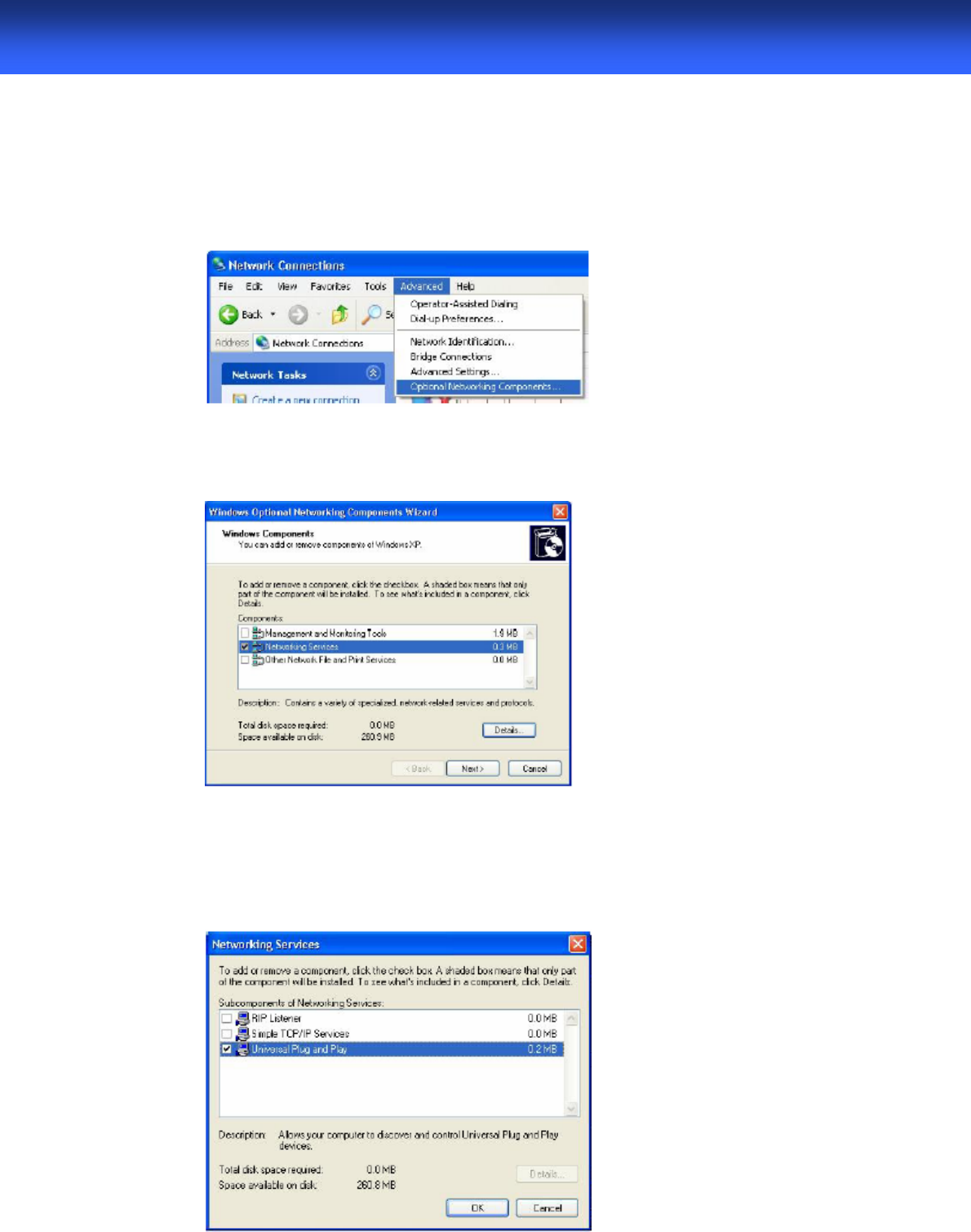
53
WLAN ADSL2+ Route
r
9.8 Installing UPnP in Windows XP
Follow the steps below to install the UPnP in Windows XP.
Step 1. Click Start and Control Panel.
Step 2. Double-click Network Connections.
Step 3. In the Network Connections window, click Advanced in the main menu and select
Optional Networking Components ….
The Windows Optional Networking Components Wizard window displays.
Step 4. Select Networking Service in the Components selection box and click Details.
Step 5. In the Networking Services window, select the Universal Plug and Play check box.
Step 6. Click OK to go back to the Windows Optional Networking Component Wizard window
and click Next.
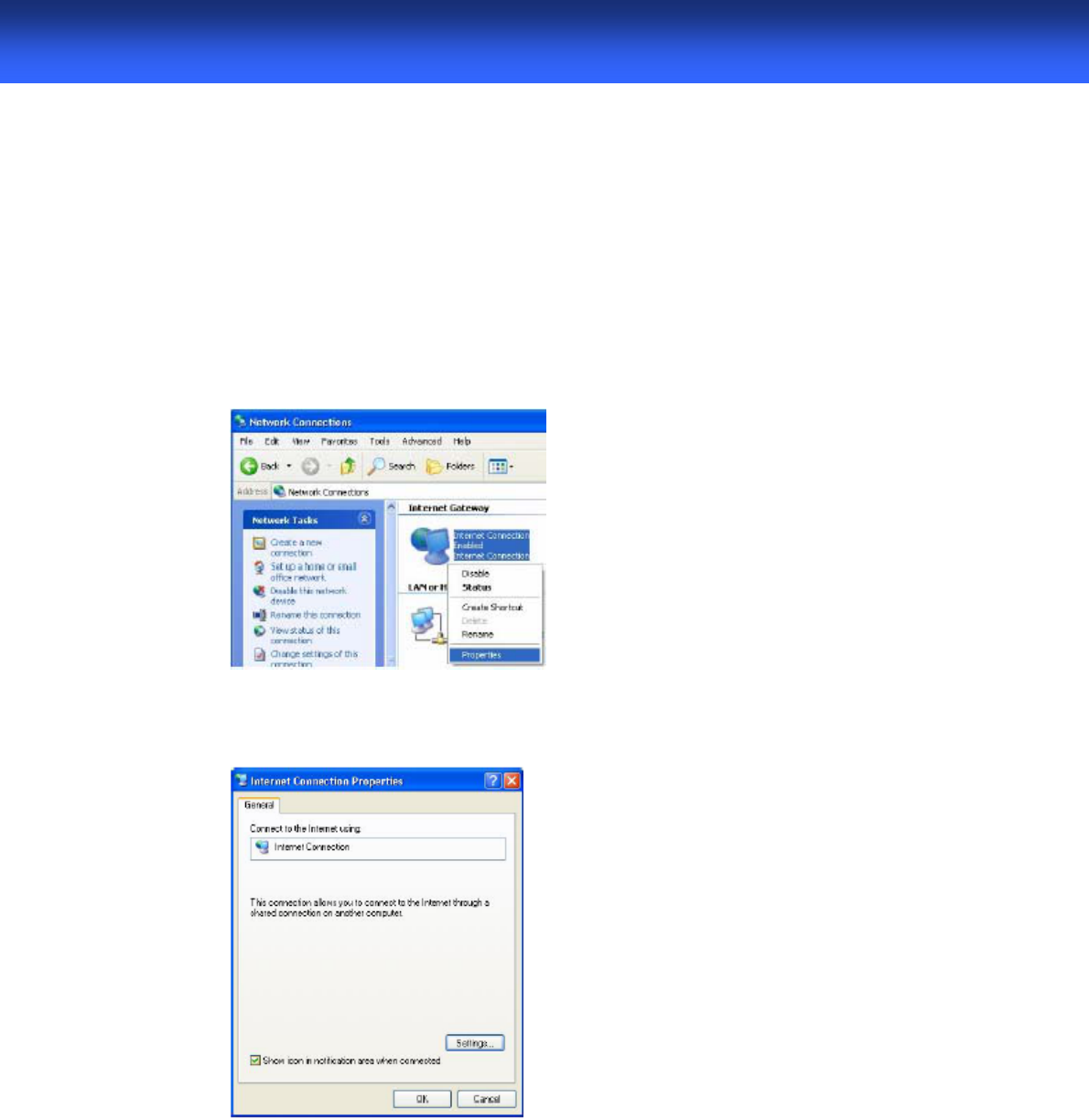
54
WLAN ADSL2+ Route
r
9.9 Using UPnP in Windows XP Example
This section shows you how to use the UPnP feature in Windows XP. You must already have
UPnP installed in Windows XP and UPnP activated on WLAN ADSL2+ Router.
Make sure the computer is connected to a LAN port of WLAN ADSL2+ Router. Turn on your
computer and WLAN ADSL2+ Router.
9.10 Auto-discover Your UPnP-enabled Network Device
Step 1. Click start and Control Panel. Double-click Network Connections. An icon displays
under Internet Gateway.
Step 2. Right-click the icon and select Properties.
Step 3. In the Internet Connection Properties window, click Settings to see the port mappings
there were automatically created.
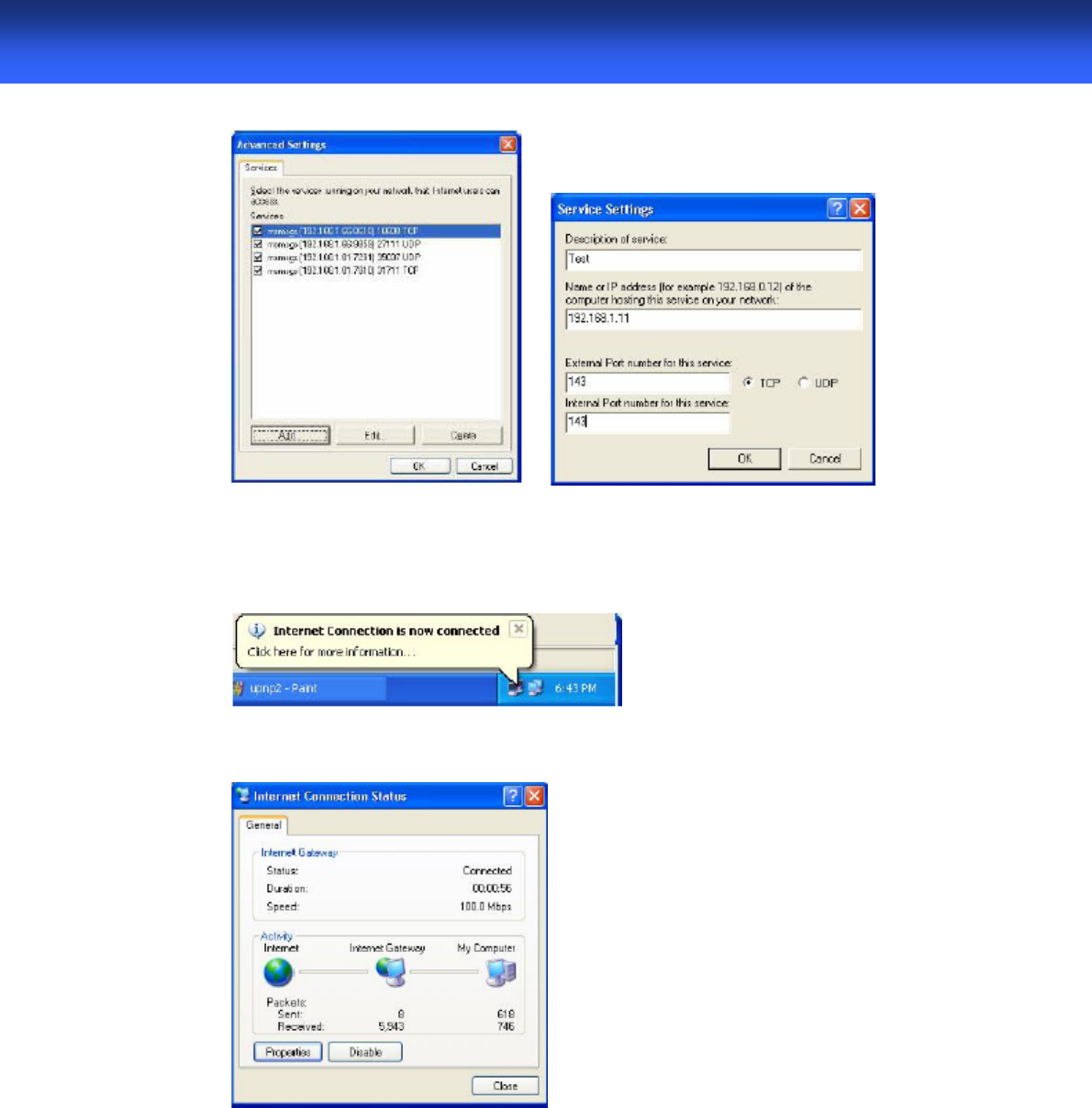
55
WLAN ADSL2+ Route
r
Step 4. You may edit or delete the port mappings or click Add to manually add port mappings.
Step 5. Select Show icon in notification area when connected option and click OK. An icon
displays in the system tray
Step 6. Double-click on the icon to display your current Internet connection status.
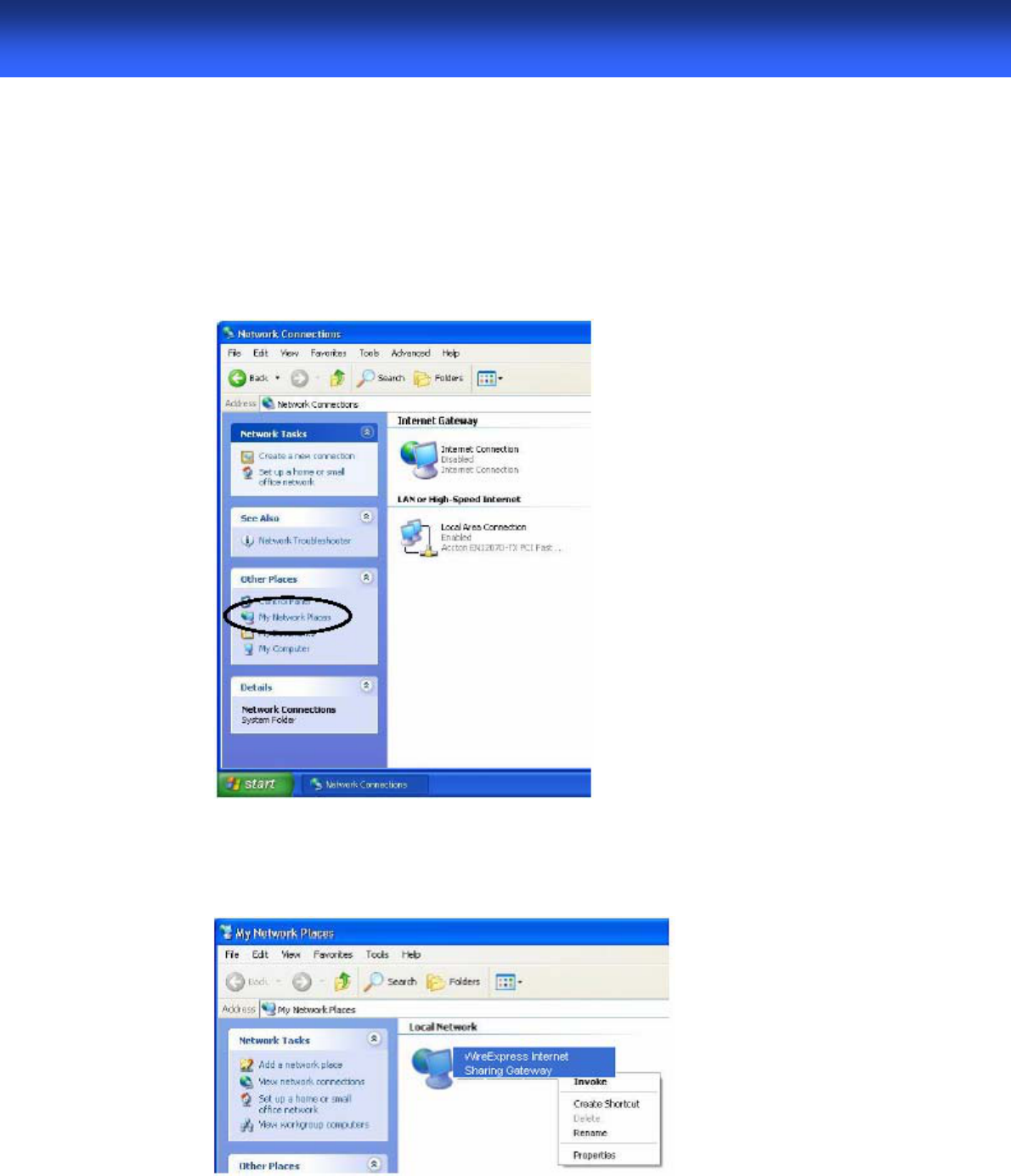
56
WLAN ADSL2+ Route
r
10.0 Web Configuration Easy Access
With UPnP, you can access the web-based configuration on WLAN ADSL2+ Router without
finding out the IP address of WLAN ADSL2+ Router first. This comes helpful if you do not know
the IP address of WLAN ADSL2+ Router.
Follow the steps below to access the web configuration.
Step 1. Click Start and then Control Panel.
Step 2. Double-click Network Connections.
Step 3. Select My Network Places under Other Places.
Step 4.An icon with the description for each UPnP-enabled device displays under Local Network.
Step 5. Right-click on the icon for yourWLAN ADSL2+ Router and select Invoke. The web
configuration login screen displays.
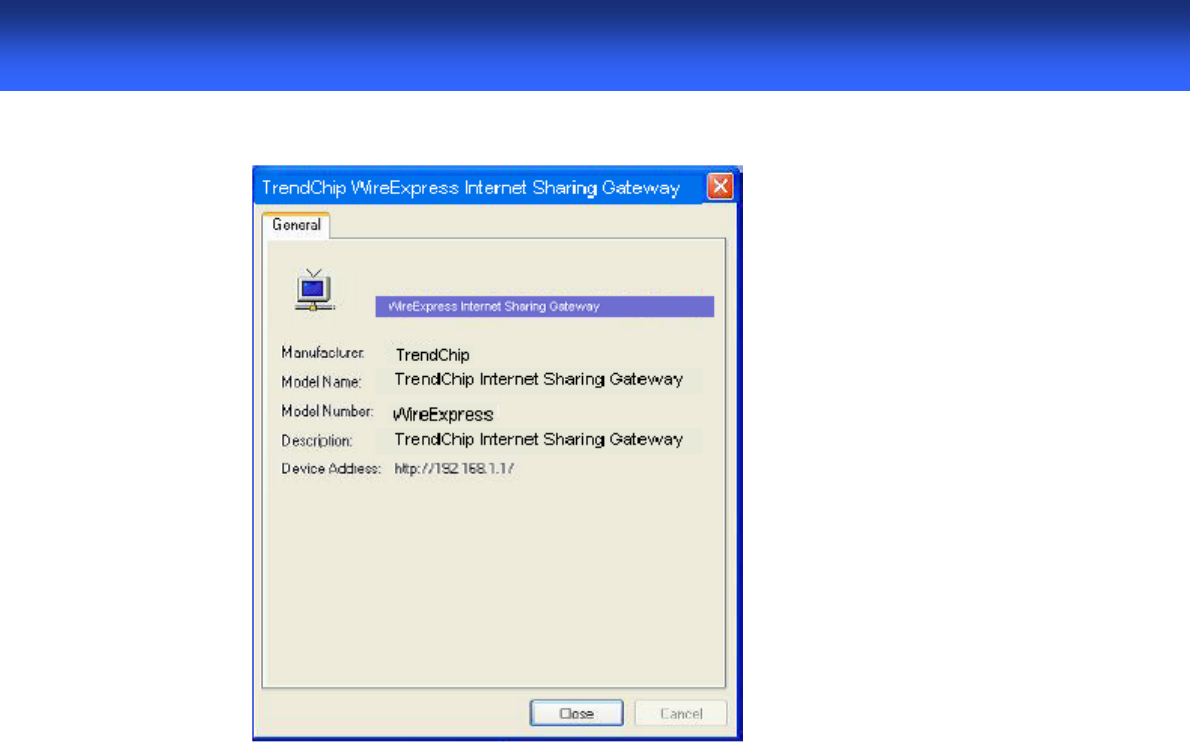
57
WLAN ADSL2+ Route
r
Step 6. Right-click on the icon for your WLAN ADSL2+ Router and select Properties. A
properties window displays with basic information about WLAN ADSL2+ Router.

58
WLAN ADSL2+ Route
r
11.0 Troubleshooting
A.1 Using LEDs to Diagnose Problems
The LEDs are useful aides for finding possible problem causes.
A.1.1 Power LED
The PWR LED on the front panel does not light up.
STEPS CORRECTIVE ACTION
1
Make sure that WLAN ADSL2+ Router’s power adaptor is connected to WLAN ADSL2+
Router and plugged in to an appropriate power source. Use only the supplied power
adaptor.
2 Check that WLAN ADSL2+ Router and the power source are both turned on and WLAN
ADSL2+ Router is receiving sufficient power.
3 Turn the WLAN ADSL2+ Router off and on.
4 If the error persists, you may have a hardware problem. In this case, you should contact
your vendor.
A.1.2 LAN LED
The LAN LED on the front panel does not light up.
STEPS CORRECTIVE ACTION
1 Check the Ethernet cable connections between your WLAN ADSL2+ Router and the
computer or hub.
2 Check for faulty Ethernet cables.
3 Make sure your computer’s Ethernet card is working properly.
4 If these steps fail to correct the problem, contact your local distributor for assistance.
A.1.3 DSL LED ( ACT & LINK)
The DSL LED on the front panel does not light up.
STEPS CORRECTIVE ACTION
1 Check the telephone wire and connections between ADSL2+ Router DSL port and the
wall jack.
2 Make sure that the telephone company has checked your phone line and set it up for
DSL service.
3 Reset your ADSL line to reinitialize your link to the DSLAM.
4 If these steps fail to correct the problem, contact your local distributor for assistance.
A.2 Telnet
I cannot telnet into WLAN ADSL2+ Router.
STEPS CORRECTIVE ACTION
1 Check the LAN port and the other Ethernet connections.
2 Make sure you are using the correct IP address of WLAN ADSL2+ Router. Check the IP
address of WLAN ADSL2+ Router.
3
Ping WLAN ADSL2+ Router from your computer.
If you cannot ping WLAN ADSL2+ Router, check the IP addresses of WLAN ADSL2+
Router and your computer. Make sure your computer is set to get a dynamic IP address;
or if you want to use a static IP address on your computer, make sure that it is on the
same subnet as WLAN ADSL2+ Router.
4 Make sure you entered the correct password. The default password is “1234”.
5 If these steps fail to correct the problem, contact the distributor.

59
WLAN ADSL2+ Route
r
A.3 Web Configuration
I cannot access the web configuration.
STEPS CORRECTIVE ACTION
1 Make sure you are using the correct IP address of WLAN ADSL2+ Router. Check the IP
address of WLAN ADSL2+ Router.
2 Make sure that there is not a console session running.
3 Check that you have enabled web service access. If you have configured a secured
client IP address, your computer’s IP address must match it.
4 For WAN access, you must configure remote management to allow server access from
the Wan (or all).
5 Your computer’s and WLAN ADSL2+ Router’s IP addresses must be on the same
subnet for LAN access.
6 If you changed WLAN ADSL2+ Router’s LAN IP address, then enter the new one as the
URL.
7 Remove any filters in LAN or WAN that block web service.
The web configuration does not display properly.
STEPS CORRECTIVE ACTION
1 Make sure you are using Internet Explorer 5.0 and later versions.
2
Delete the temporary web files and log in again.
In Internet Explorer, click Tools, Internet Options and then click the Delete Files ...
button.
When a Delete Files window displays, select Delete all offline content and click OK.
(Steps may vary depending on the version of your Internet browser.)
A.4 Login Username and Password
I forgot my login username and/or password.
STEPS CORRECTIVE ACTION
1
If you have changed the password and have now forgotten it, you will need to upload
the default configuration file. This will erase all custom configurations and restore all of
the factory defaults including the password.
2 Press the RST button for five seconds, and then release it. When the LINK LED begins
to blink, the defaults have been restored and WLAN ADSL2+ Router restarts.
3
The default username is “admin”. The default password is “1234”. The Password and
Username fields are case-sensitive. Make sure that you enter the correct password and
username using the proper casing.
4 It is highly recommended to change the default username and password. Make sure
you store the username and password in a save place.
A.5 LAN Interface
I cannot access WLAN ADSL2+ Router from the LAN or ping any computer on the LAN.
STEPS CORRECTIVE ACTION
1
Check the Ethernet LEDs on the front panel. A LAN LED should be on if the port is
connected to a computer or hub. If the LAN LEDs on the front panel are off, refer to
Section A.1.2.
2 Make sure that the IP address and the subnet mask of WLAN ADSL2+ Router and your
computer(s) are on the same subnet.

60
WLAN ADSL2+ Route
r
A.6 WAN Interface
Initialization of the ADSL connection failed.
STEPS CORRECTIVE ACTION
1 Check the cable connections between the ADSL port and the wall jack. The DSL LEDs
on the front panel of WLAN ADSL2+ Router should be on.
2 Check that your VPI, VCI, type of encapsulation and type of multiplexing settings are
the same as what you collected from your telephone company and ISP.
3
Restart WLAN ADSL2+ Router. If you still have problems, you may need to verify your
VPI, VCI, type of encapsulation and type of multiplexing settings with the telephone
company and ISP.
I cannot get a WAN IP address from the ISP.
STEPS CORRECTIVE ACTION
1 The ISP provides the WAN IP address after authenticating you. Authentication may be
through the user name and password, the MAC address or the host name.
2
The username and password apply to PPPoE and PPoA encapsulation only. Make
sure that you have entered the correct Service Type, User Name and Password (be
sure to use the correct casing).
A.7 Internet Access
I cannot access the Internet.
STEPS CORRECTIVE ACTION
1 Make sure WLAN ADSL2+ Router is turned on and connected to the network.
2 If the DSL LEDs are off, refer to Section A.1.3.
3 Verify your WAN settings.
4 Make sure you entered the correct user name and password.
Internet connection disconnects.
STEPS CORRECTIVE ACTION
1 Check the schedule rules.
2 If you use PPPoA or PPPoE encapsulation, check the idle time-out setting.
3 Contact your ISP.
A.8 Remote Node Connection
I cannot connect to a remote node or ISP.
STEPS CORRECTIVE ACTION
1 Check WAN screen to verify that the username and password are entered properly.
2 Verify your login name and password for the remote node.
3 If these steps fail, you may need to verify your login and password with your ISP.